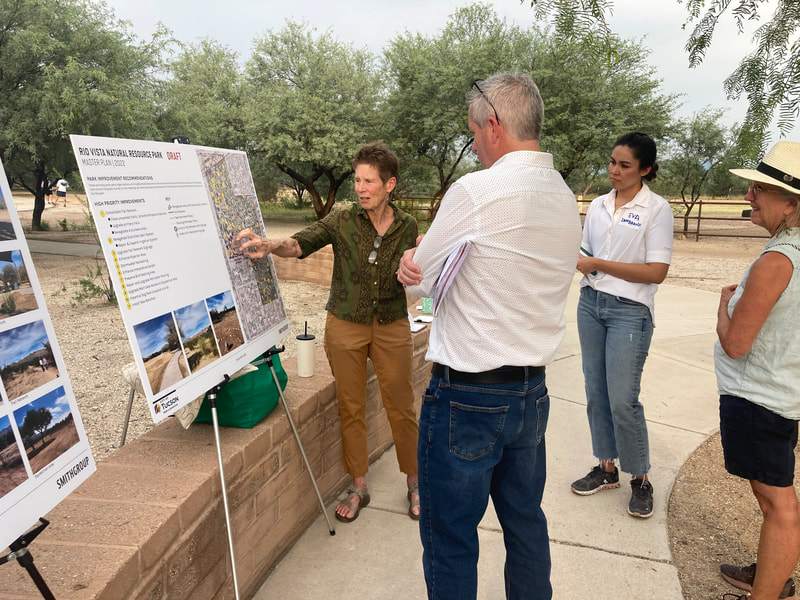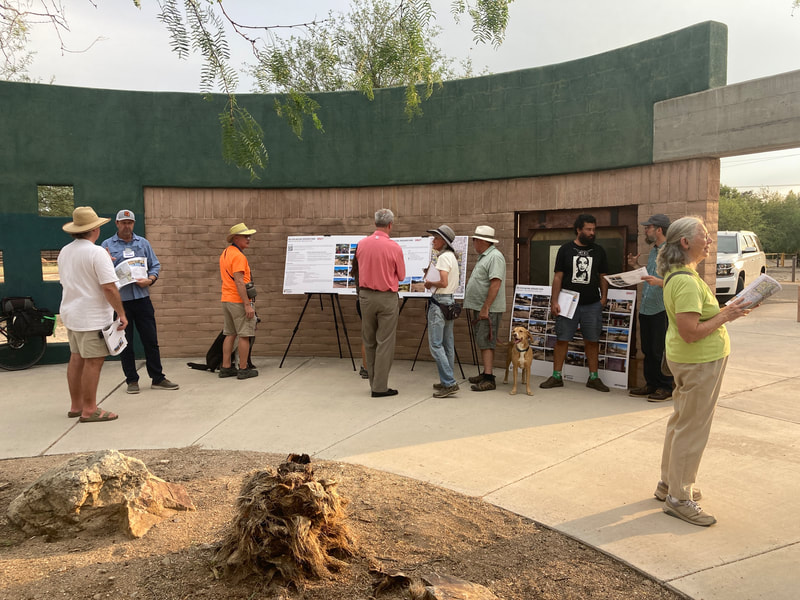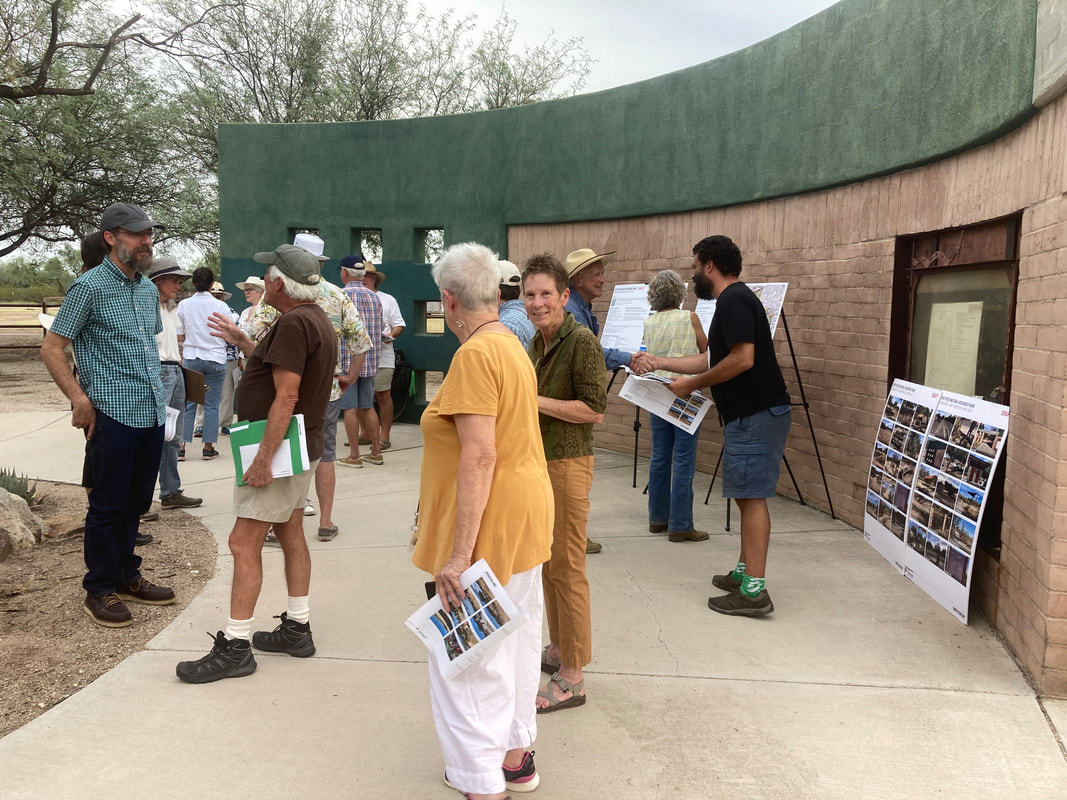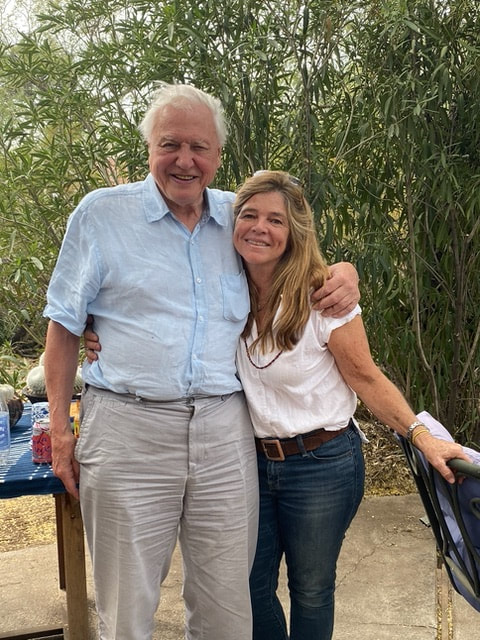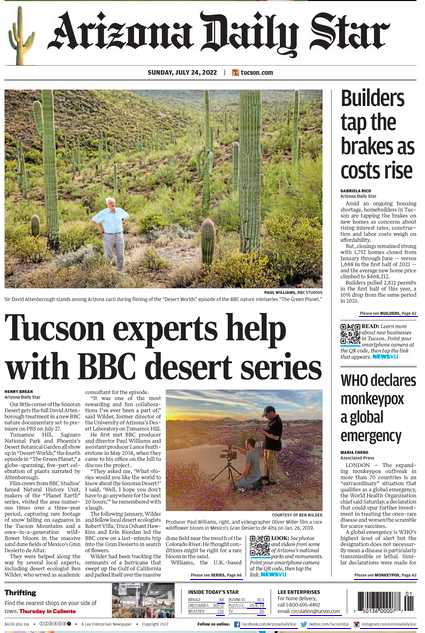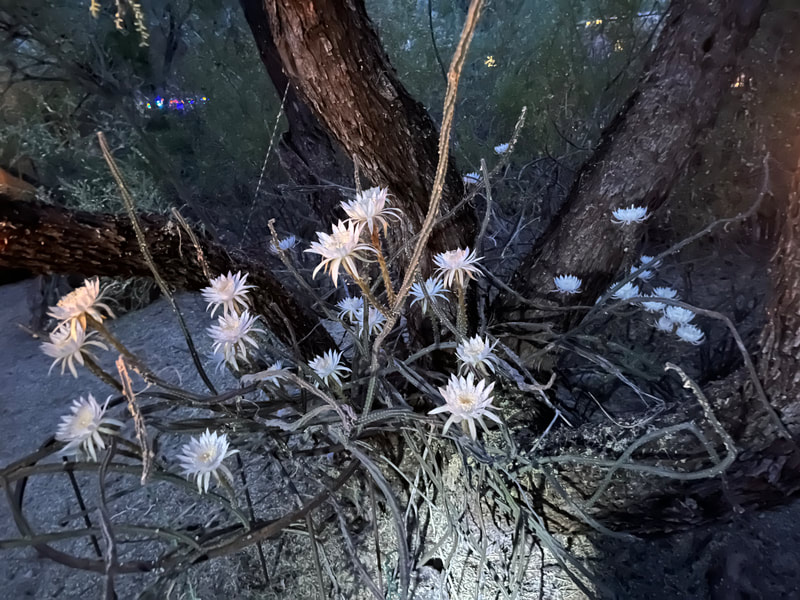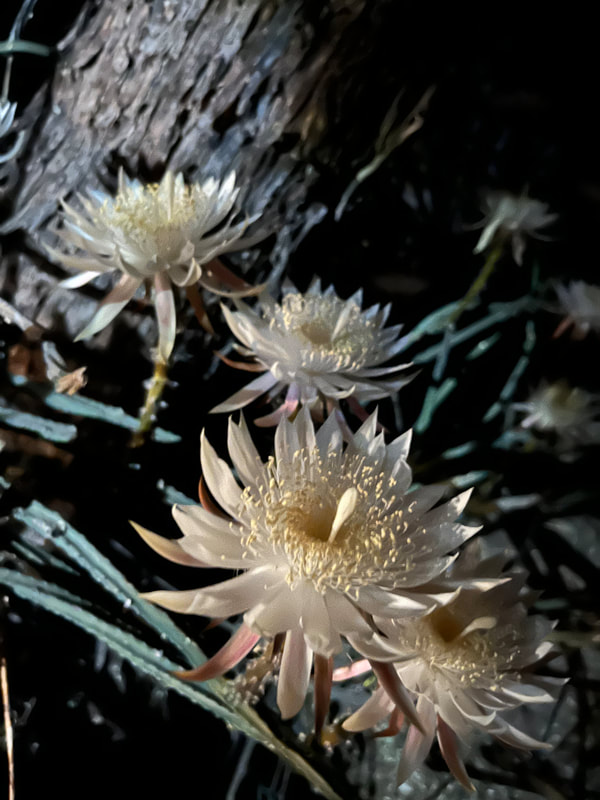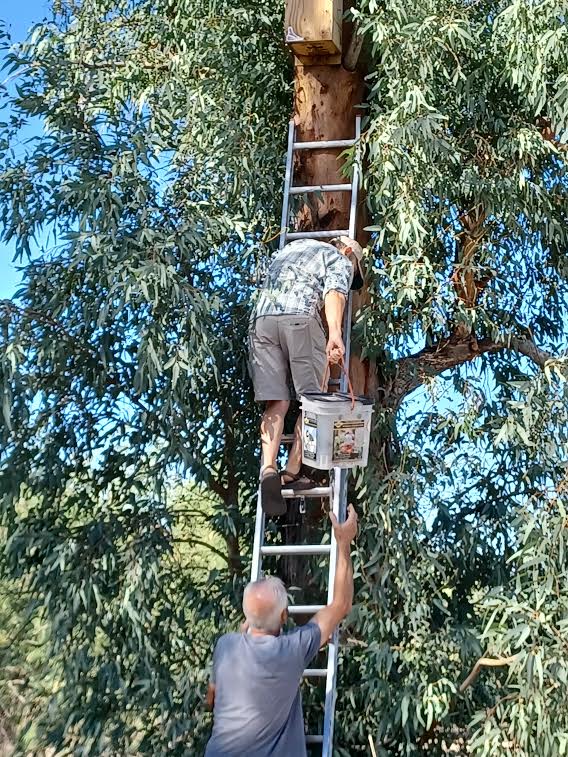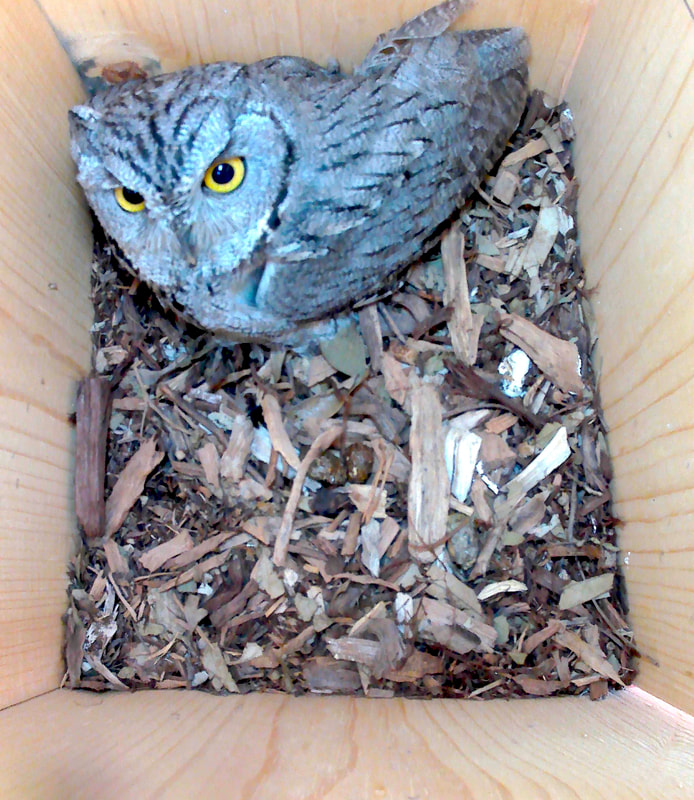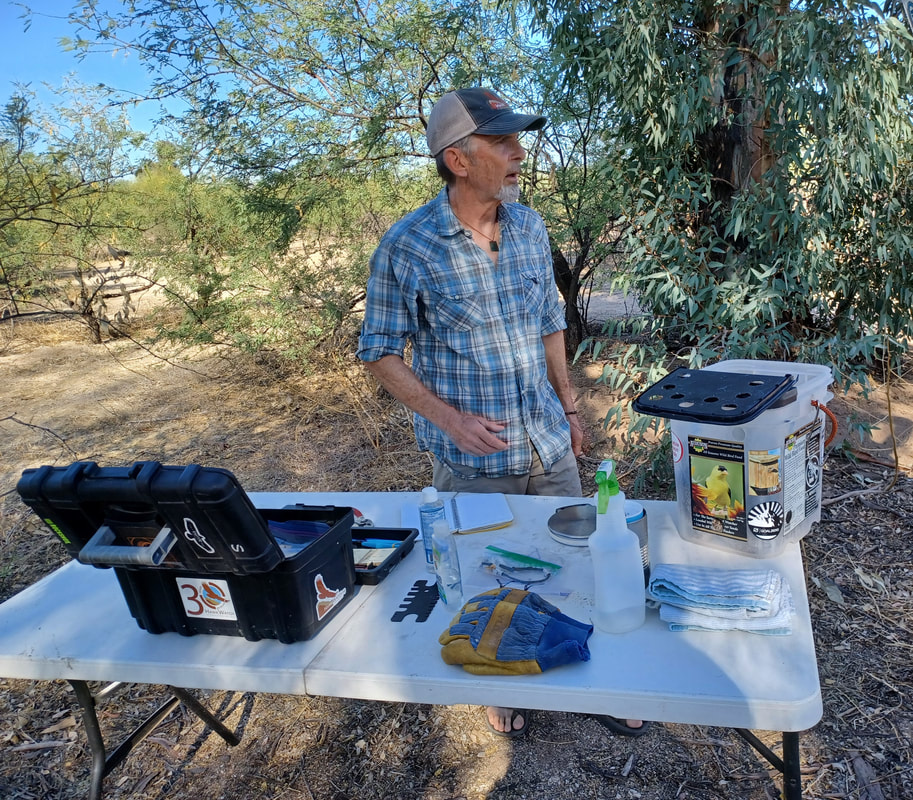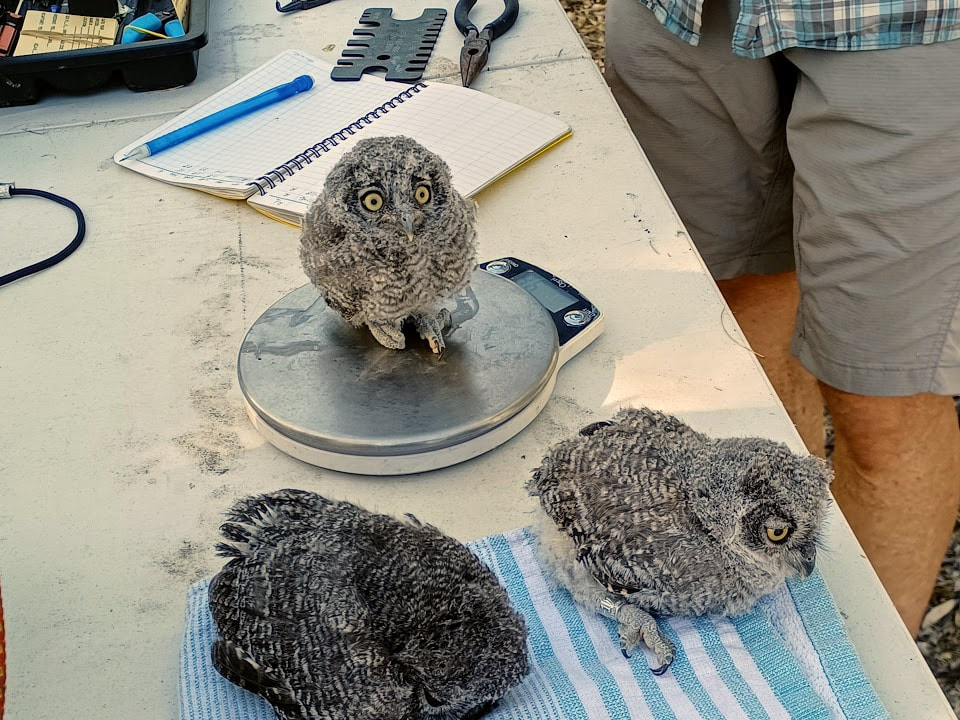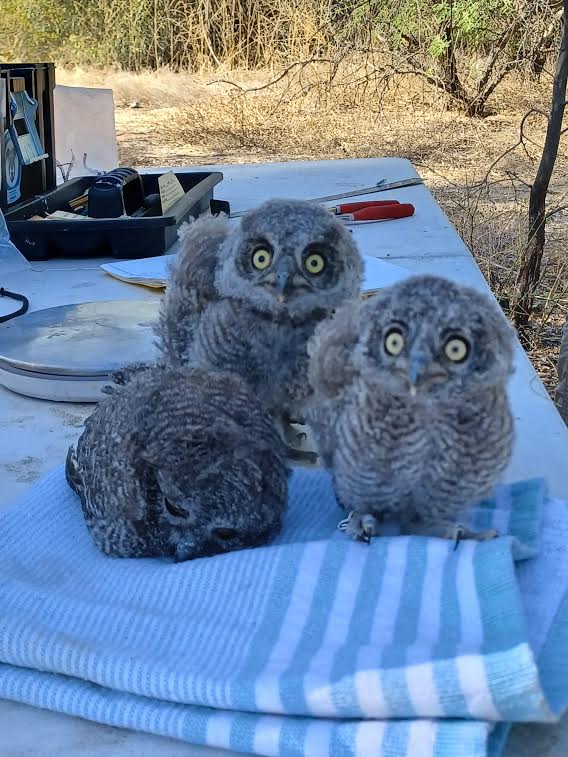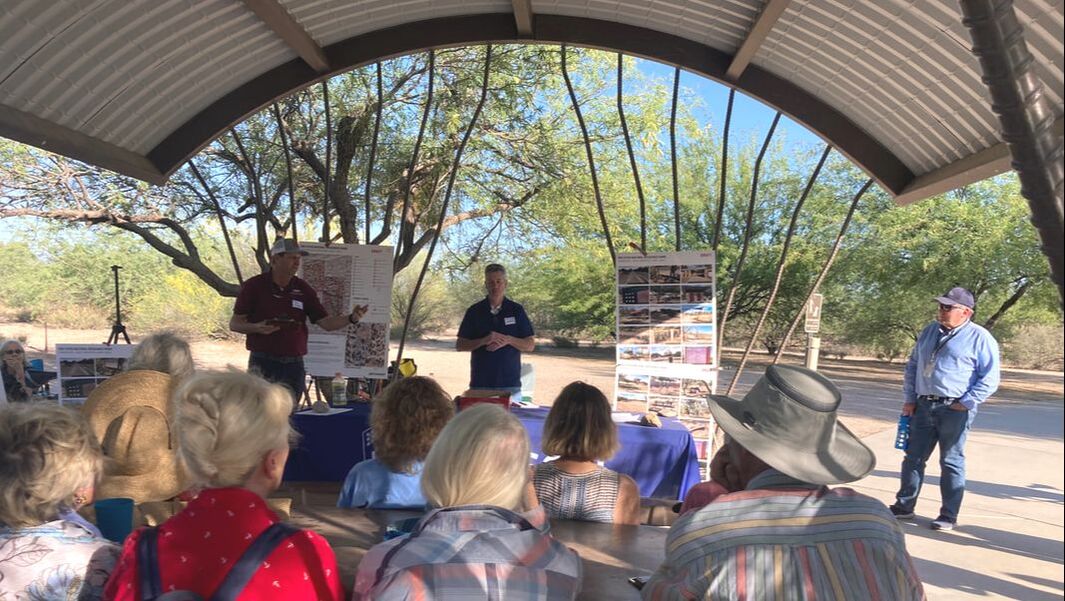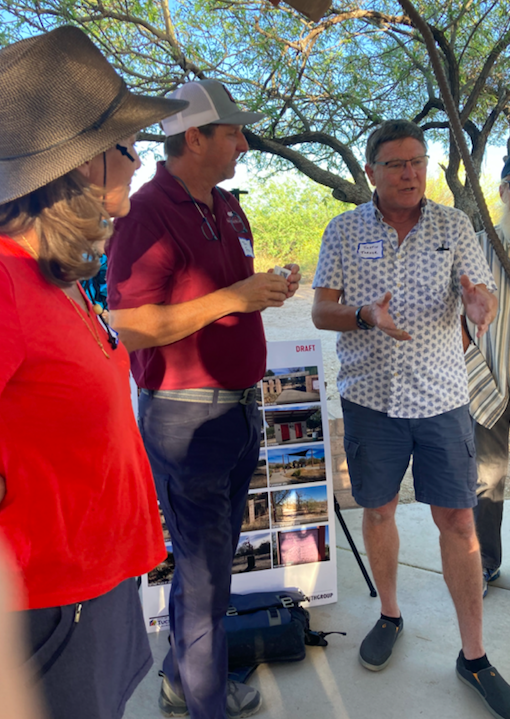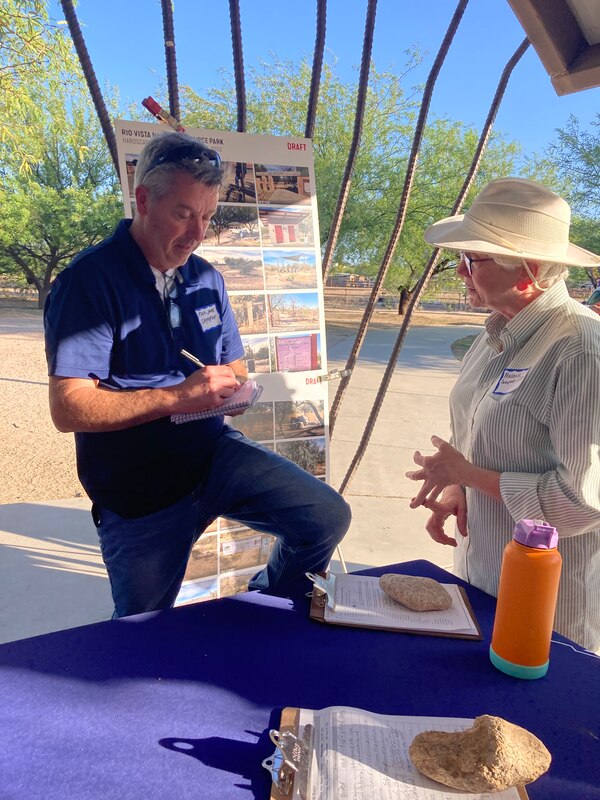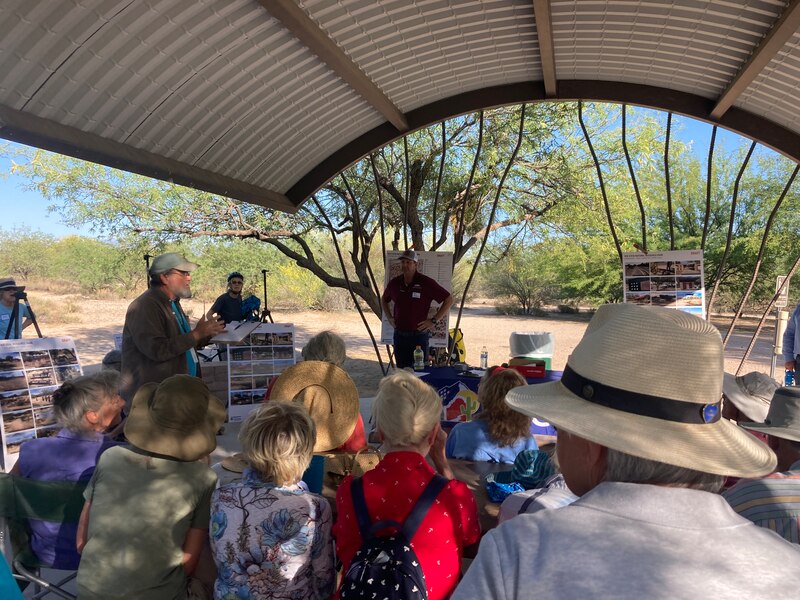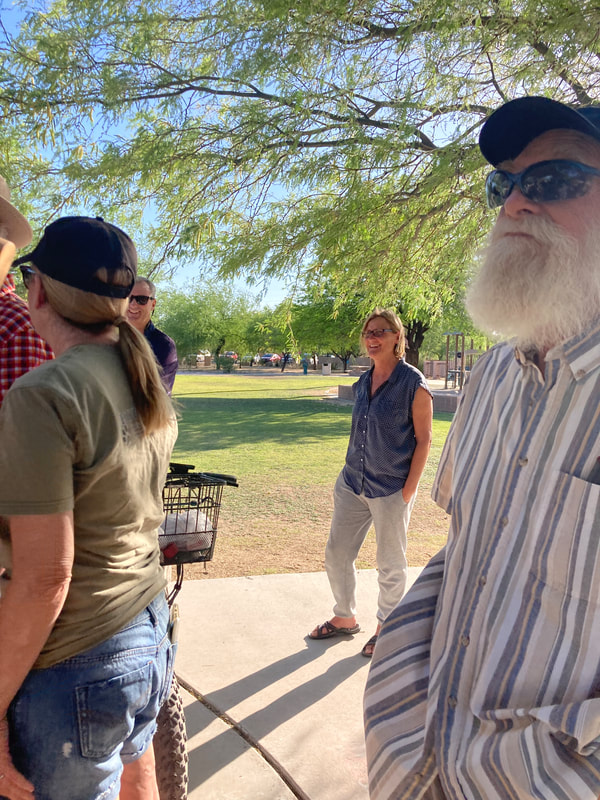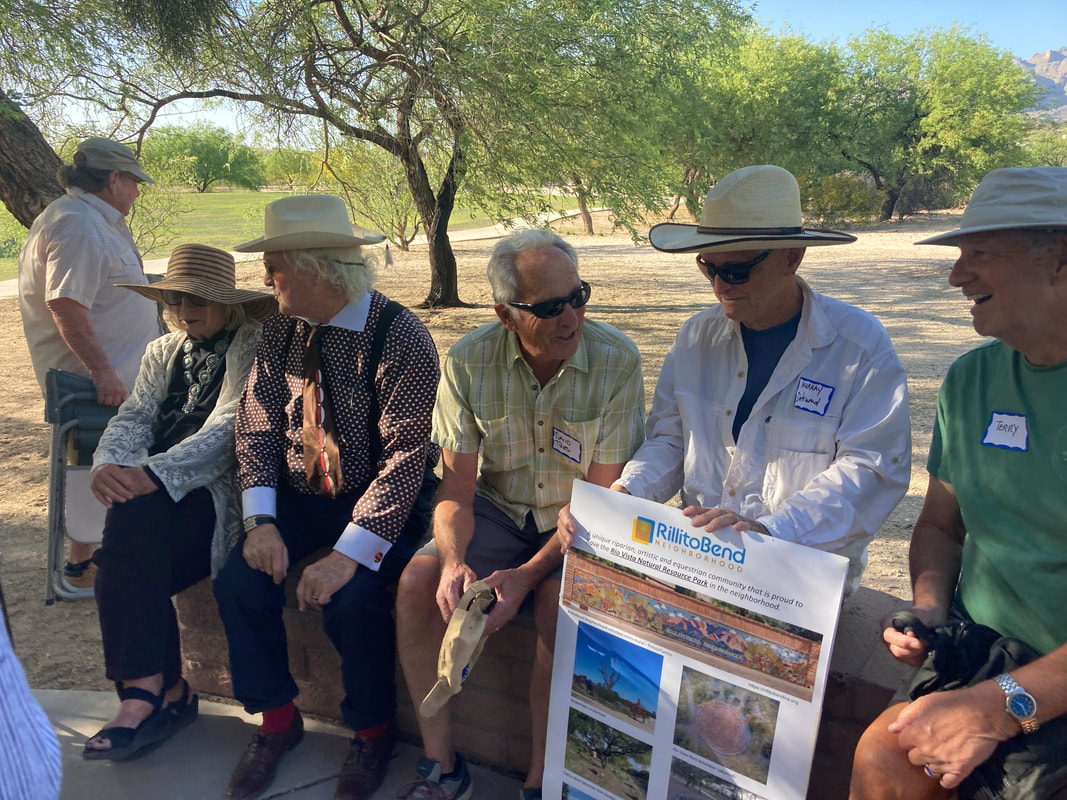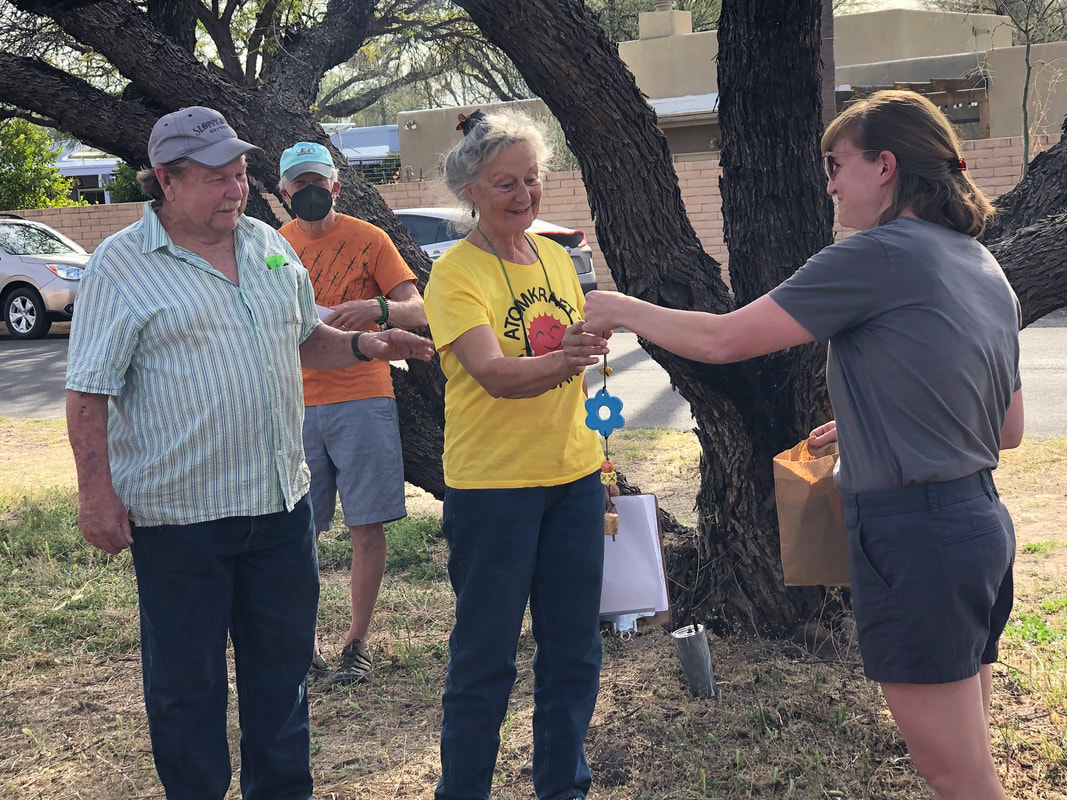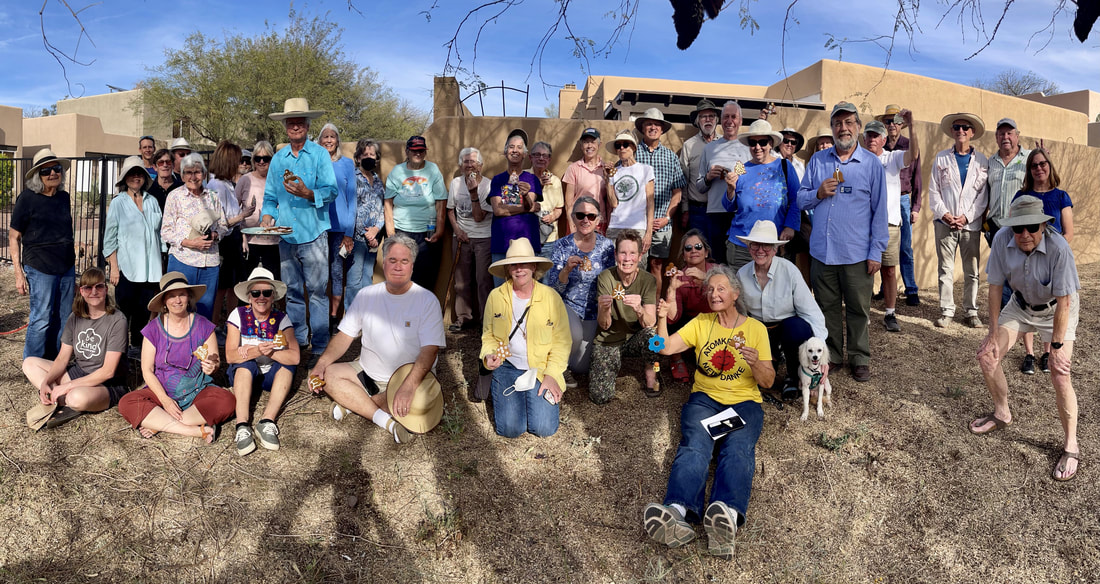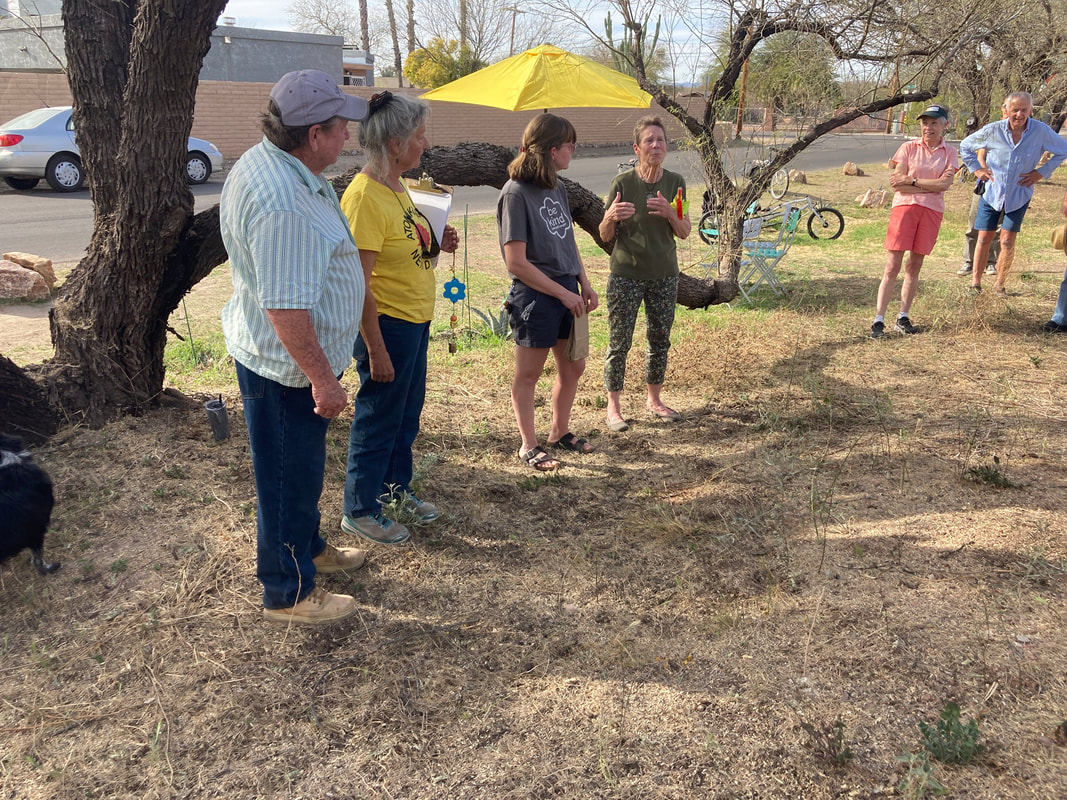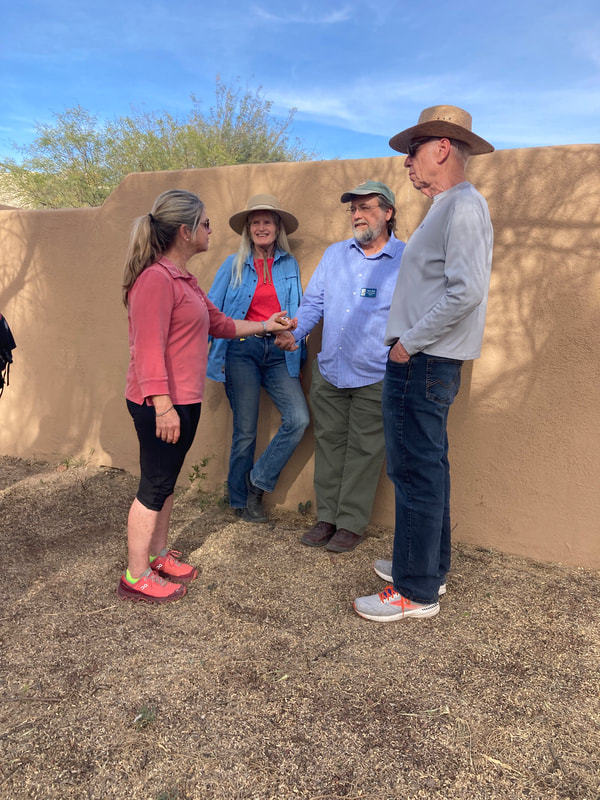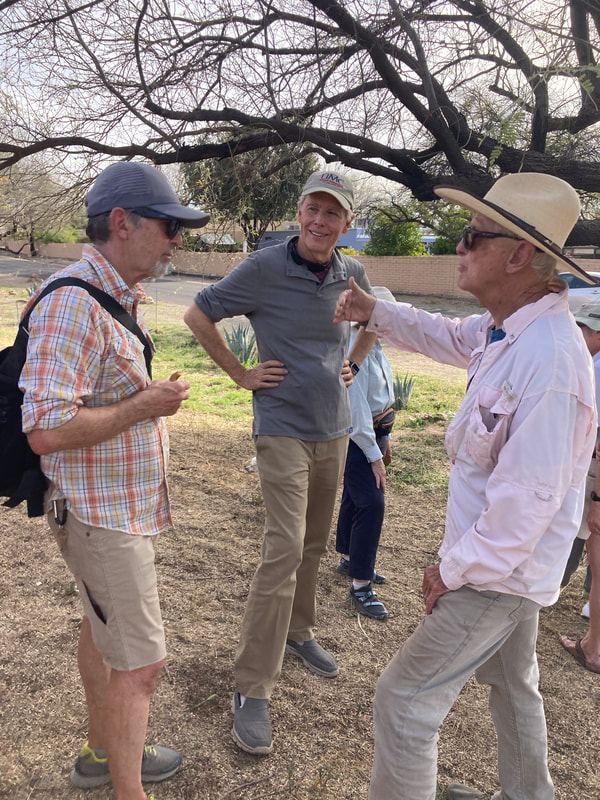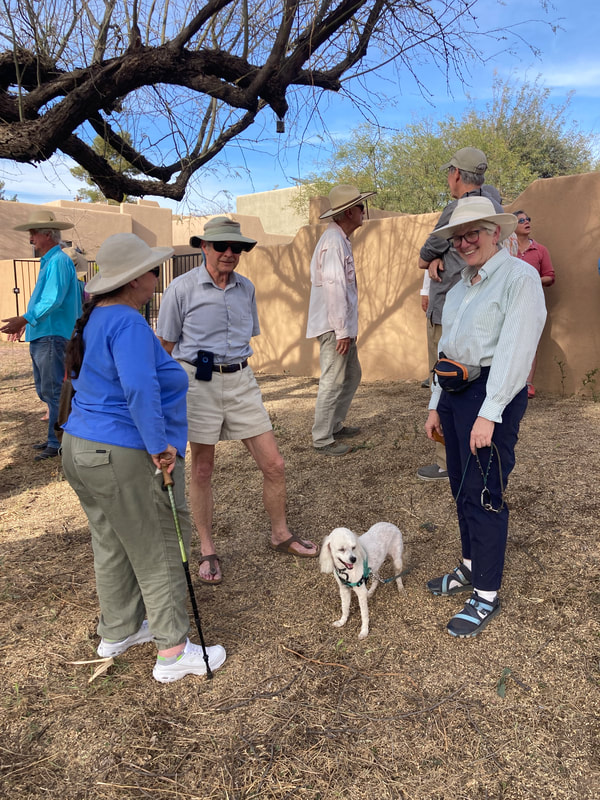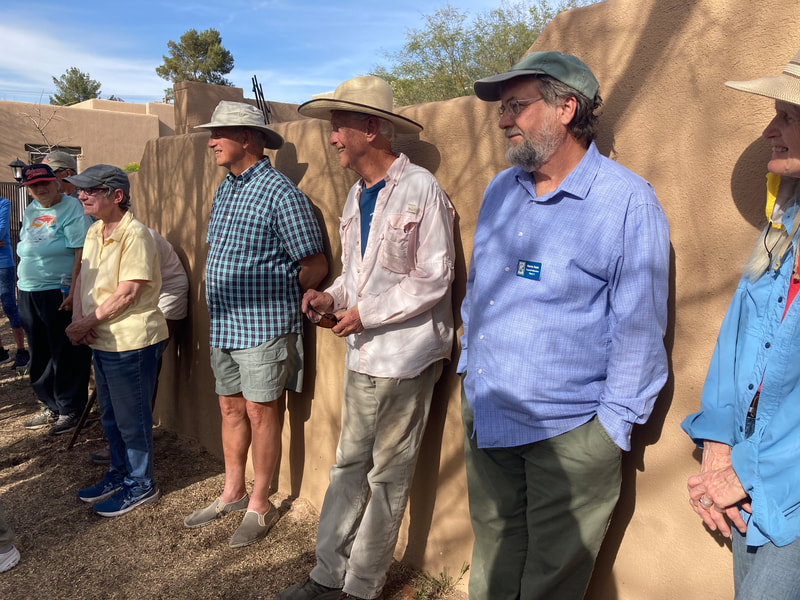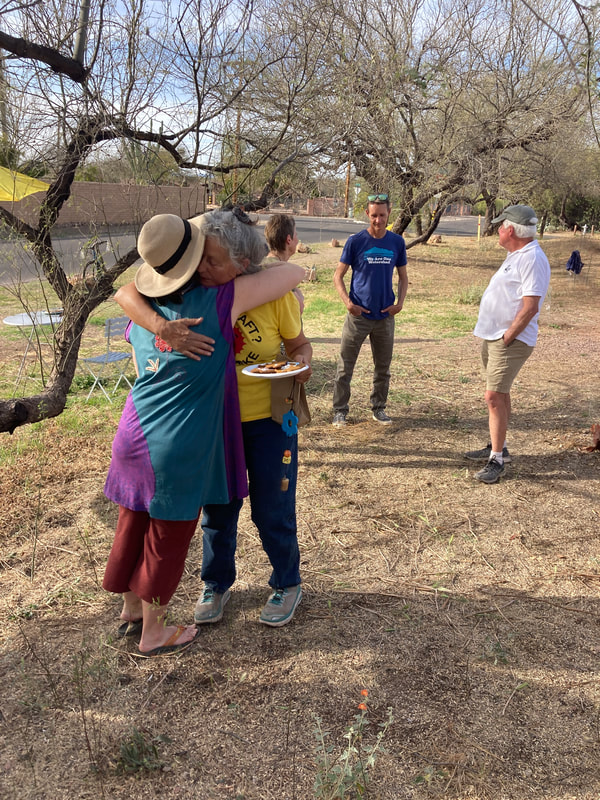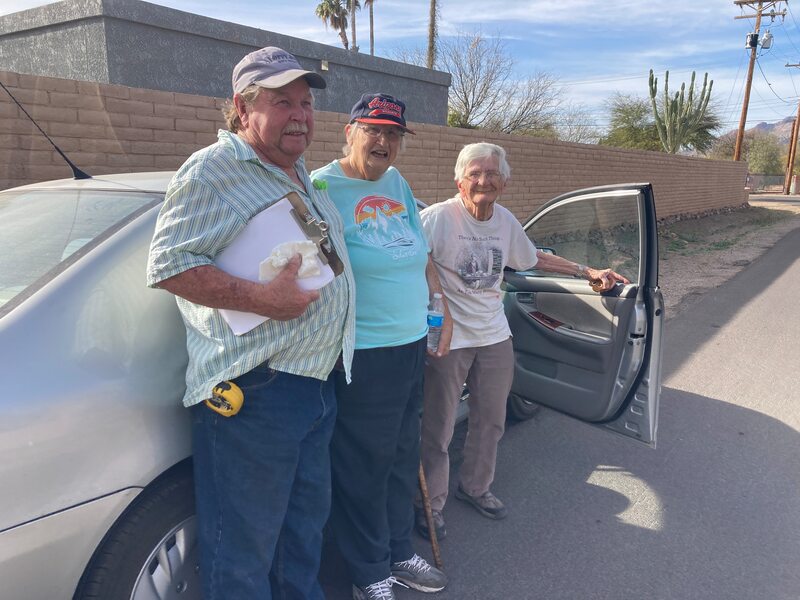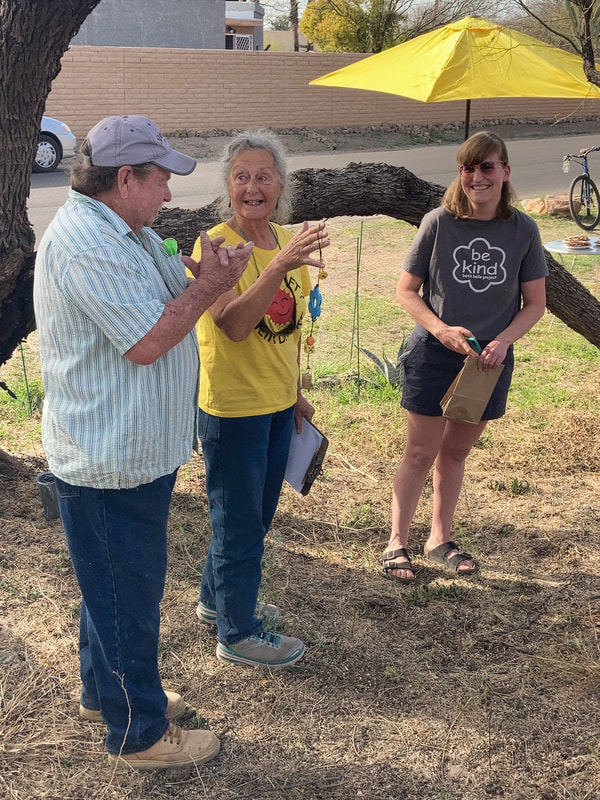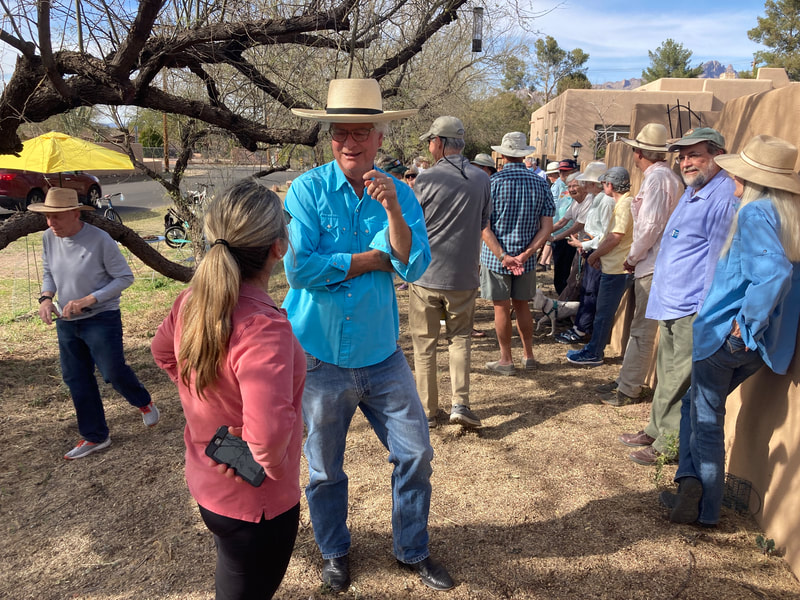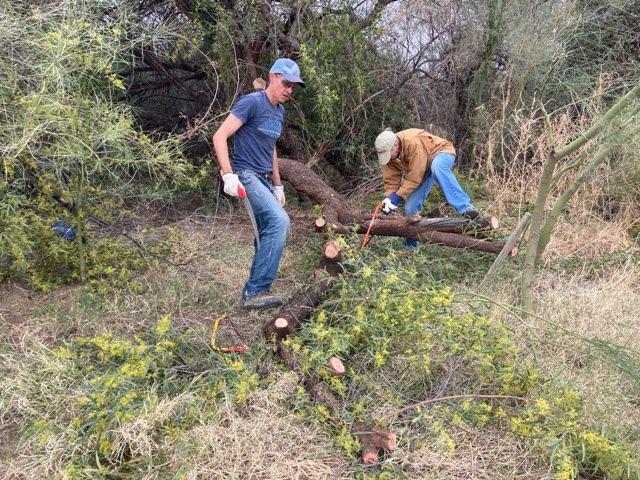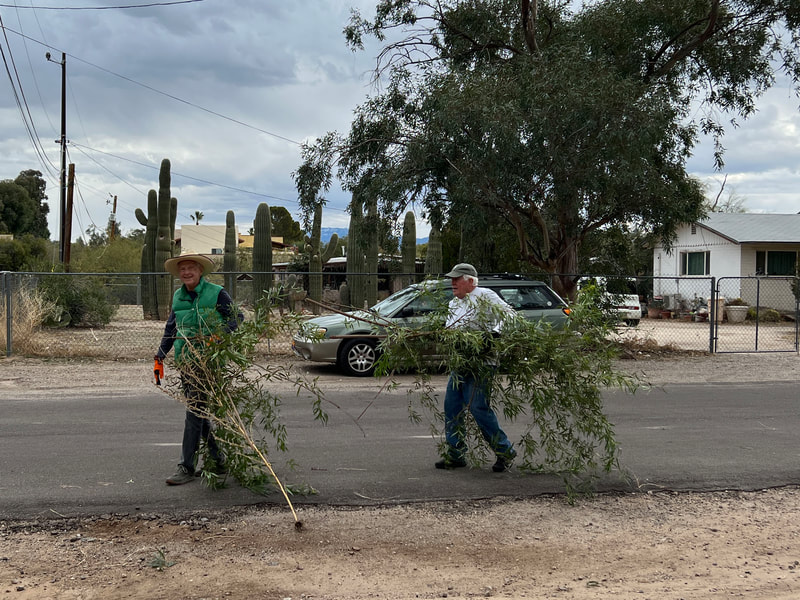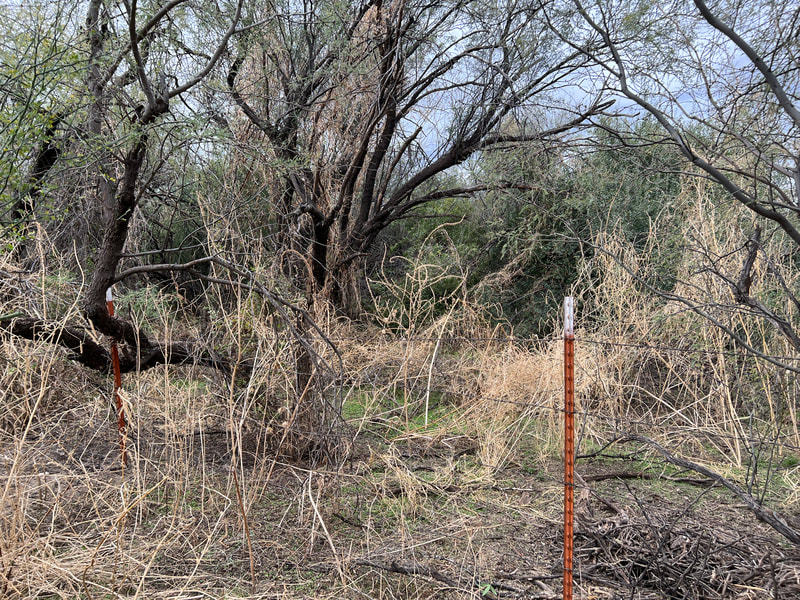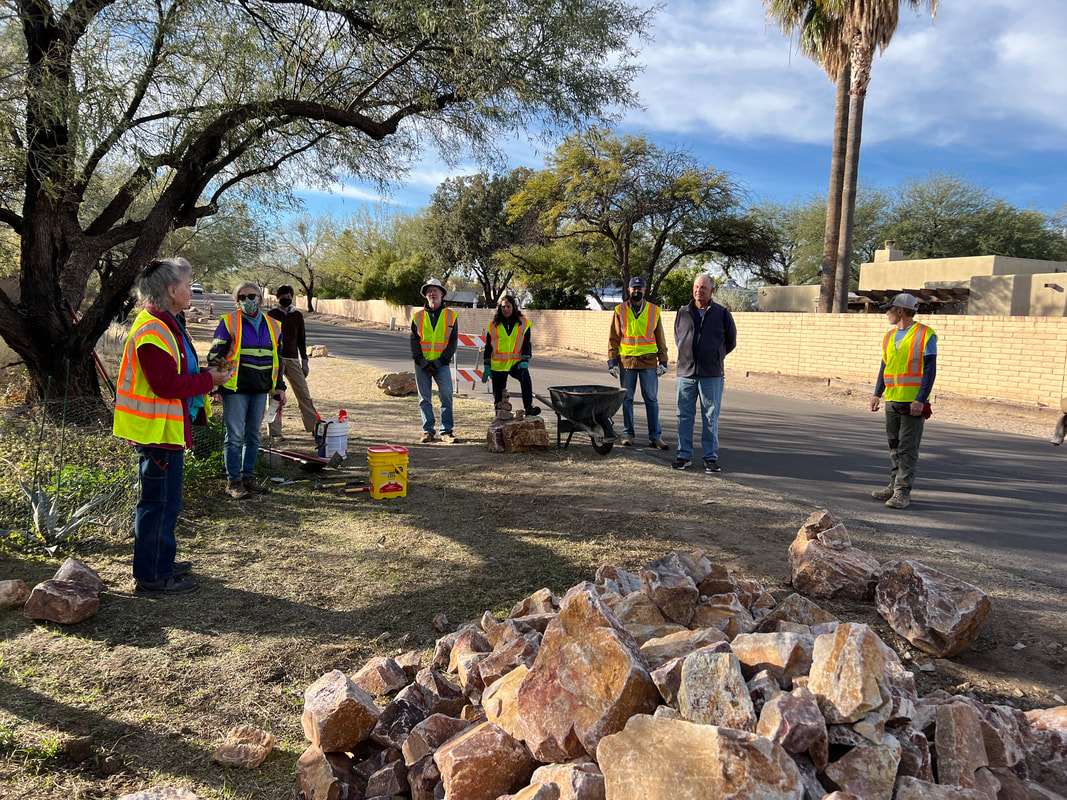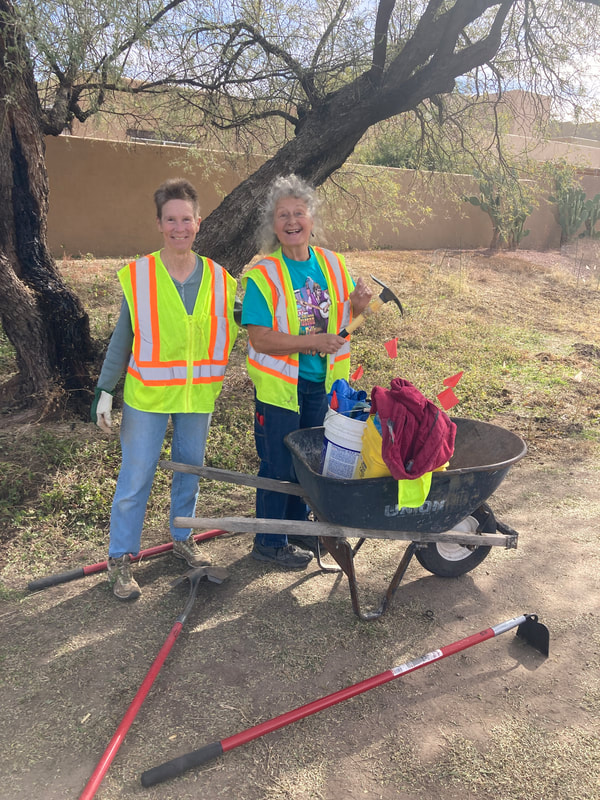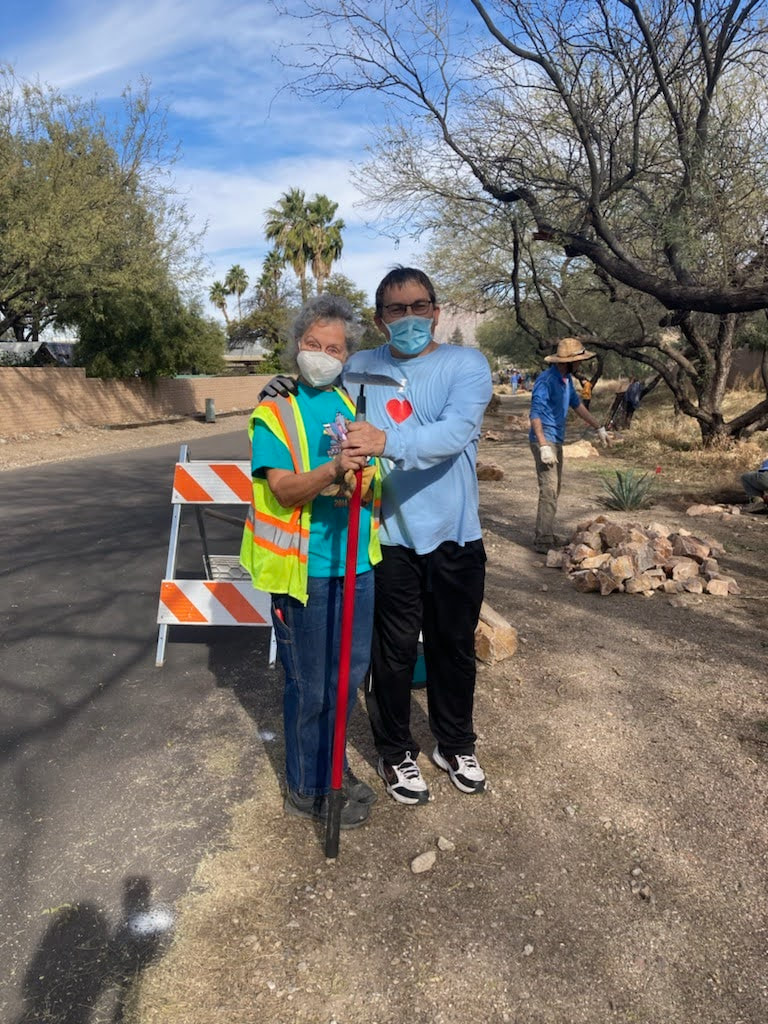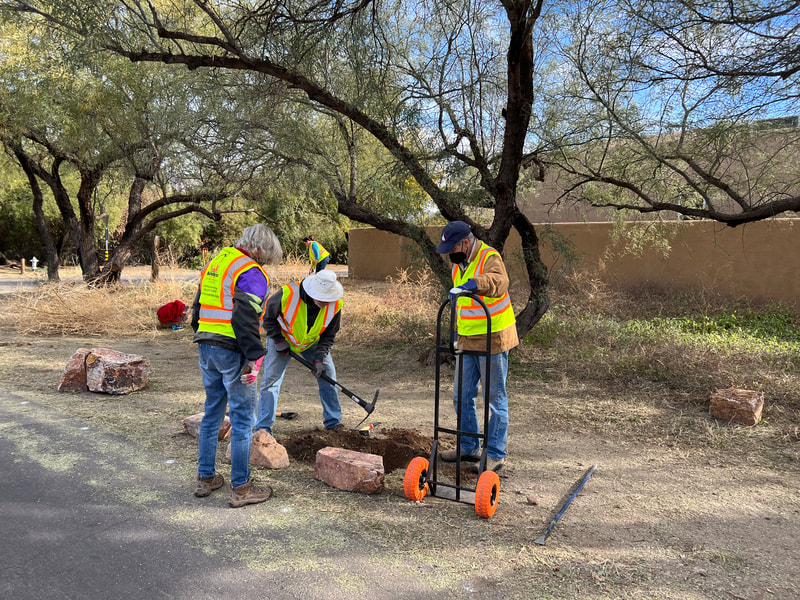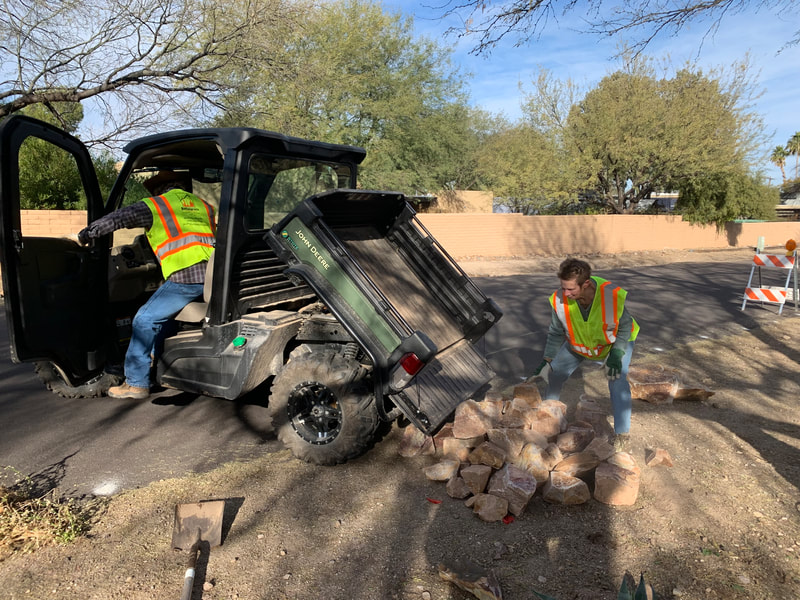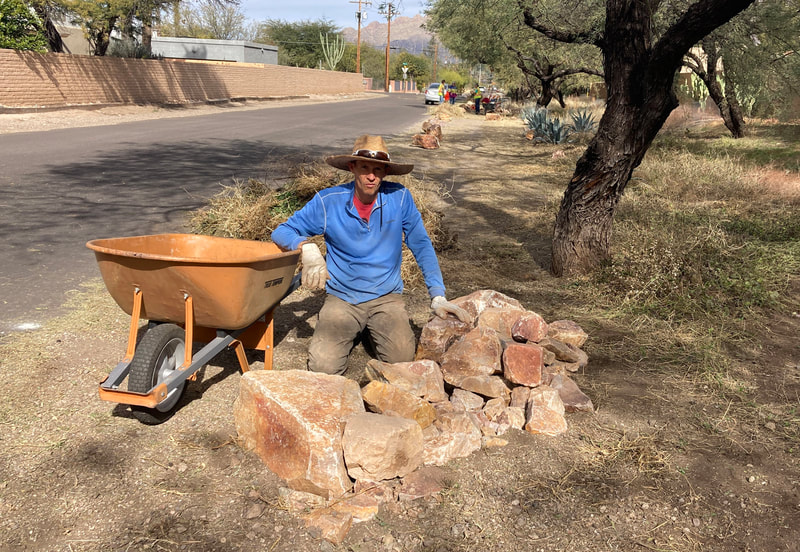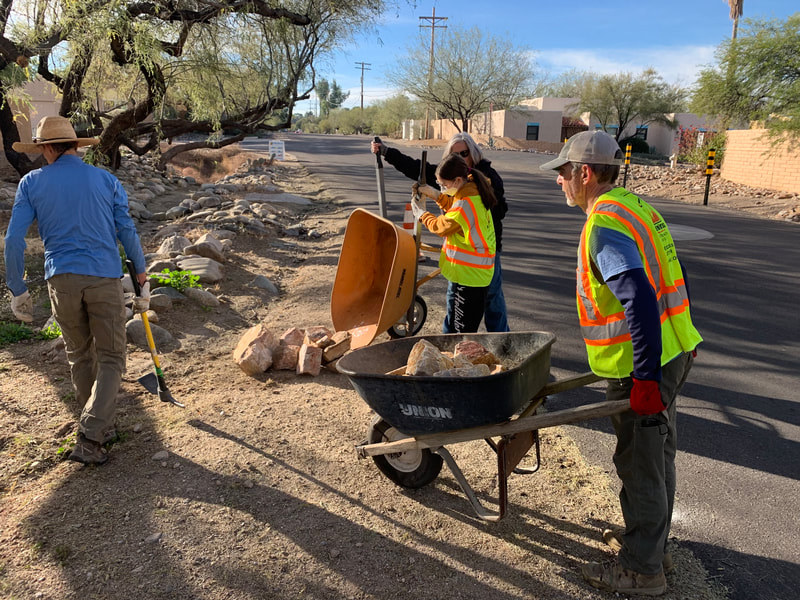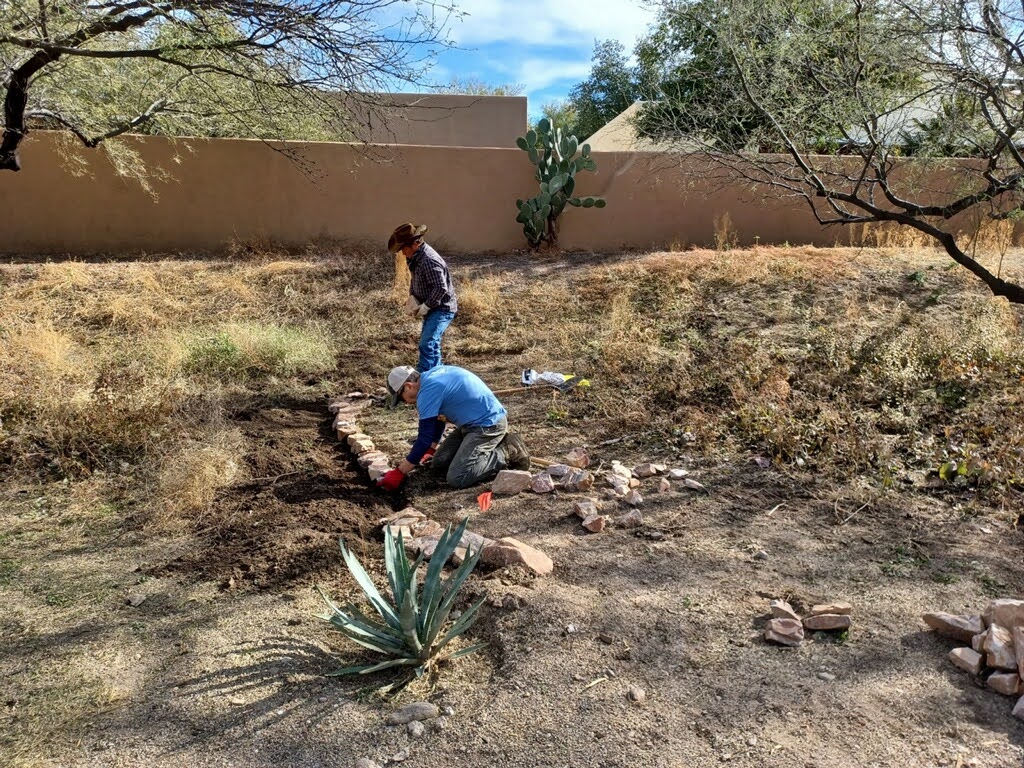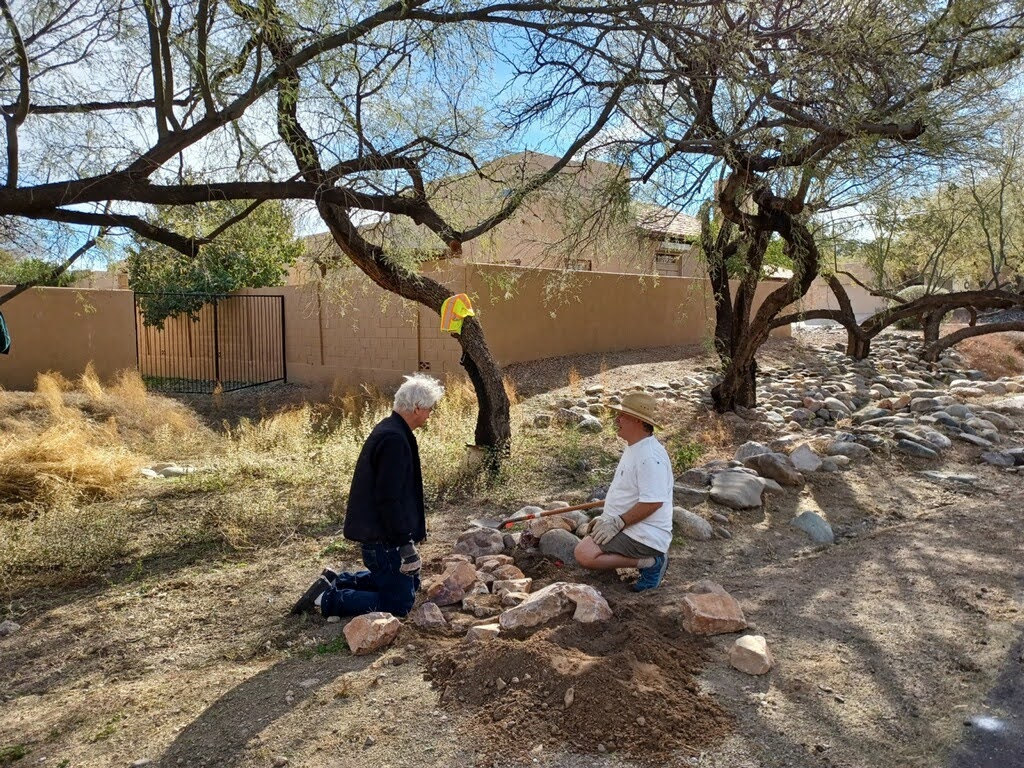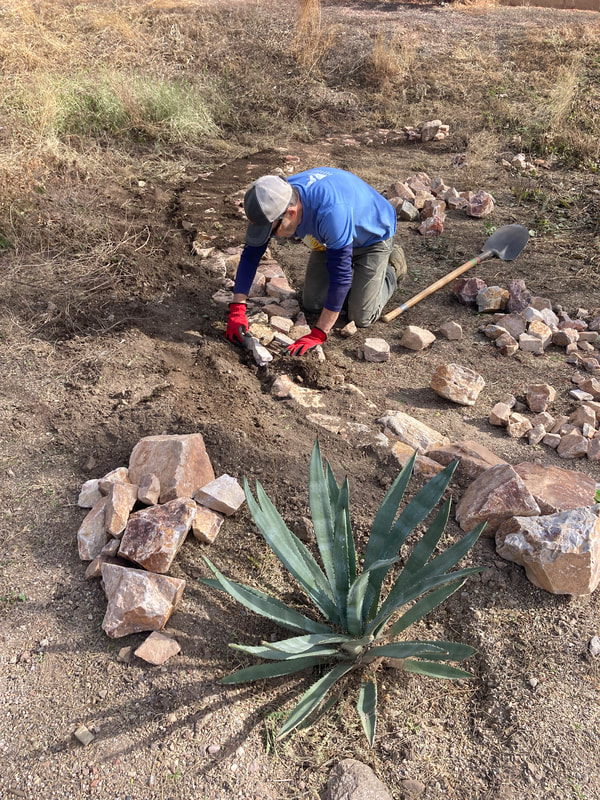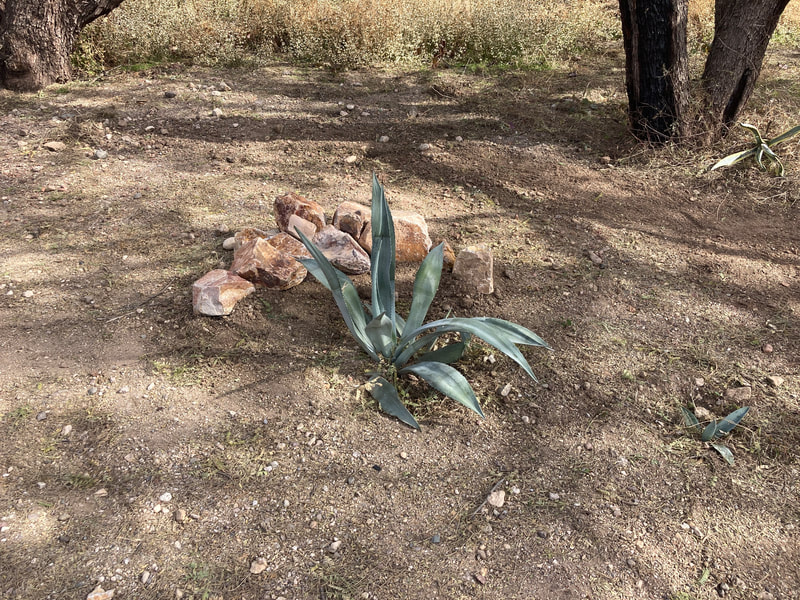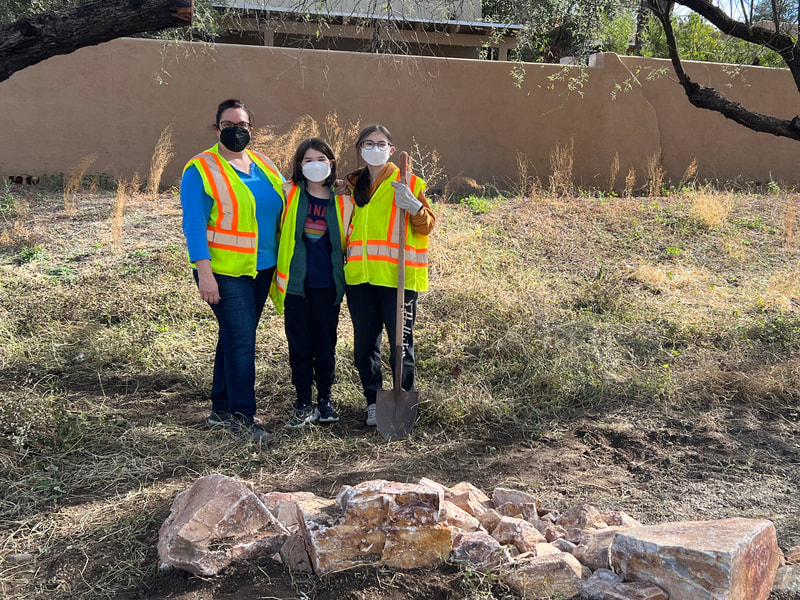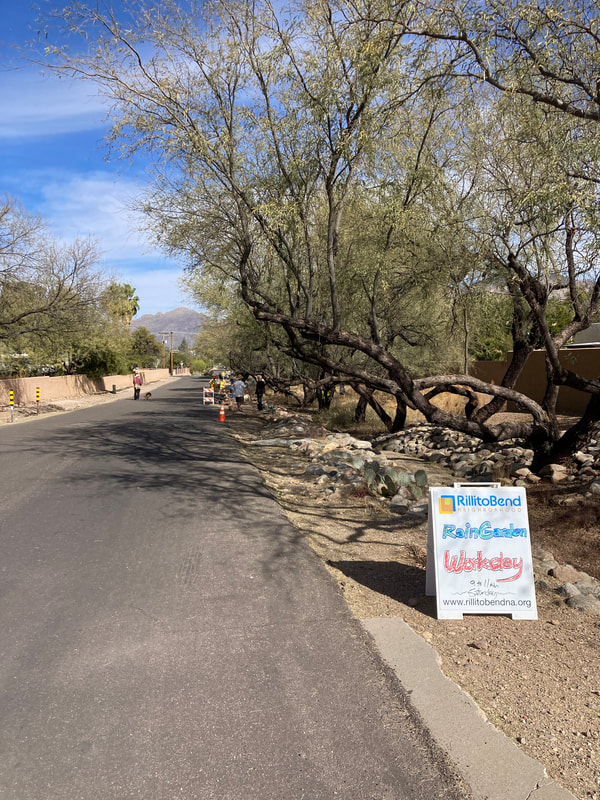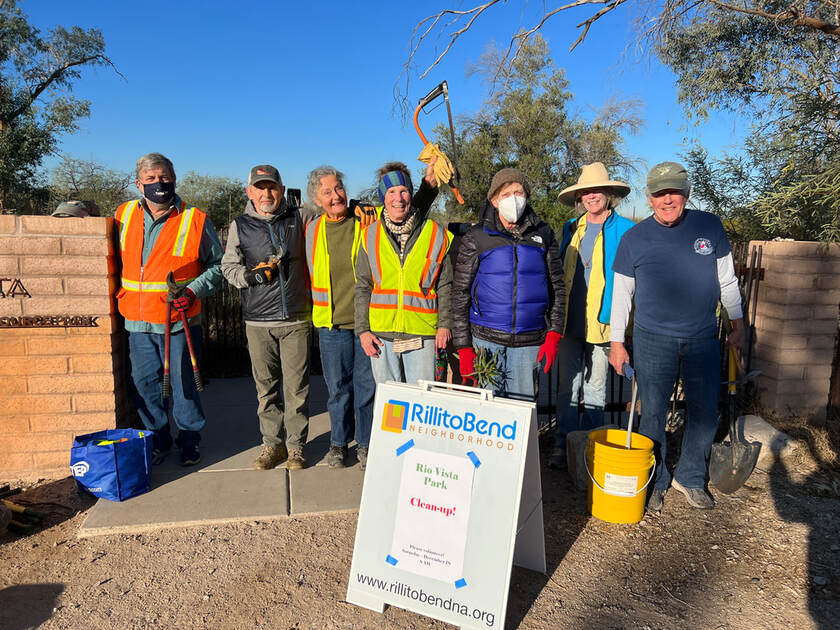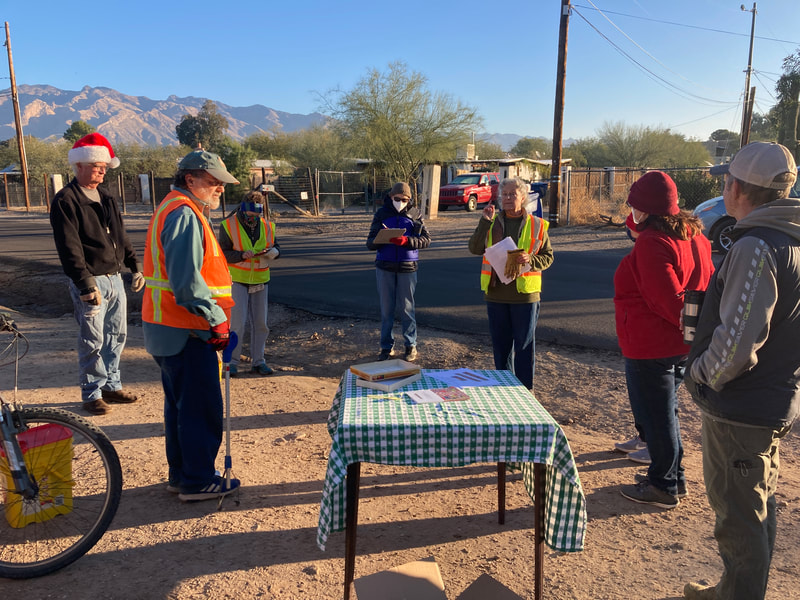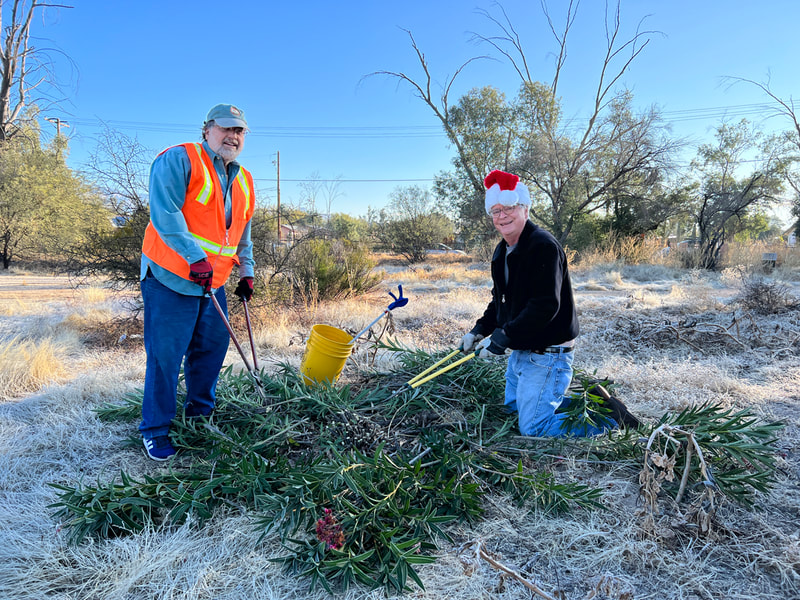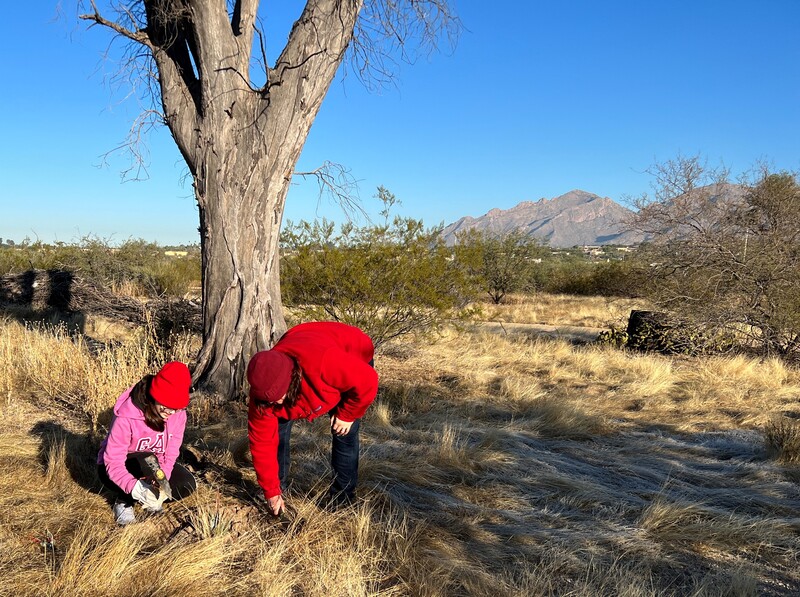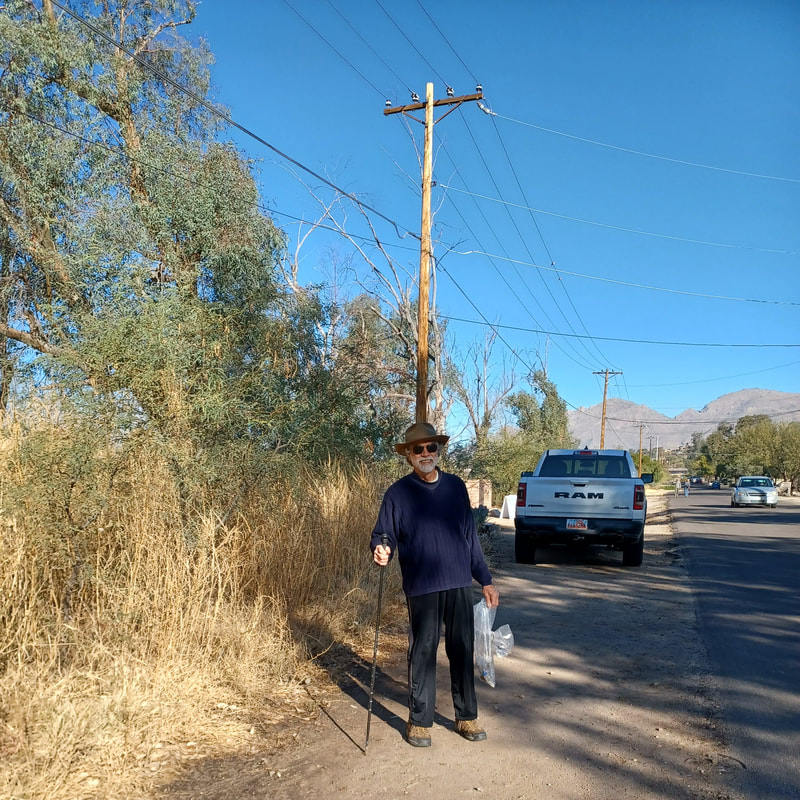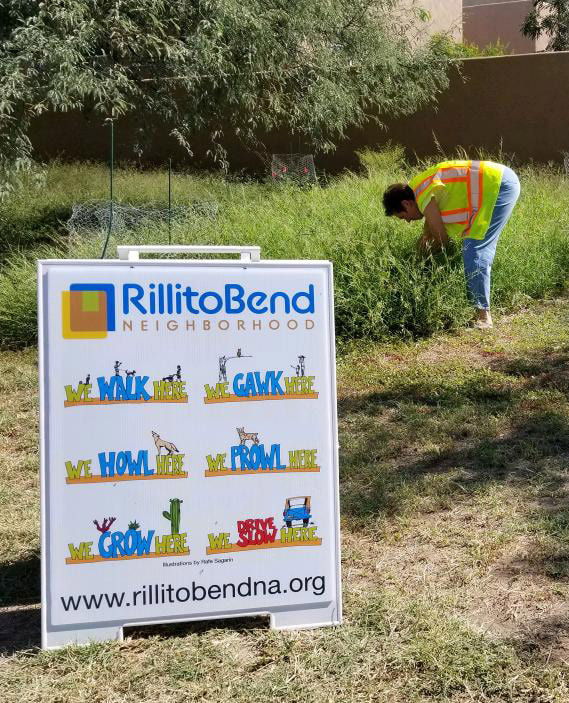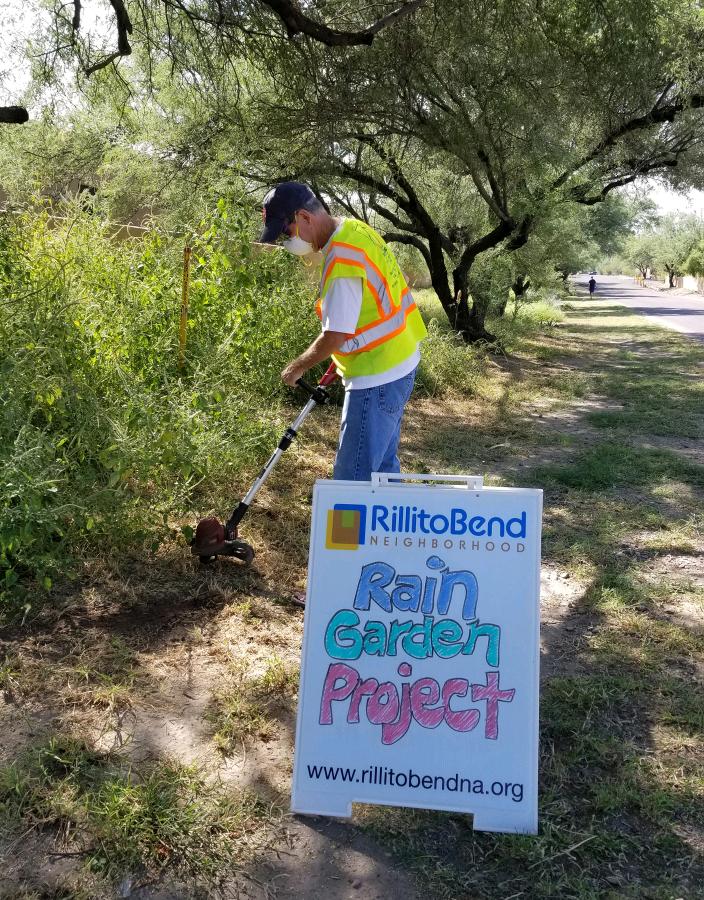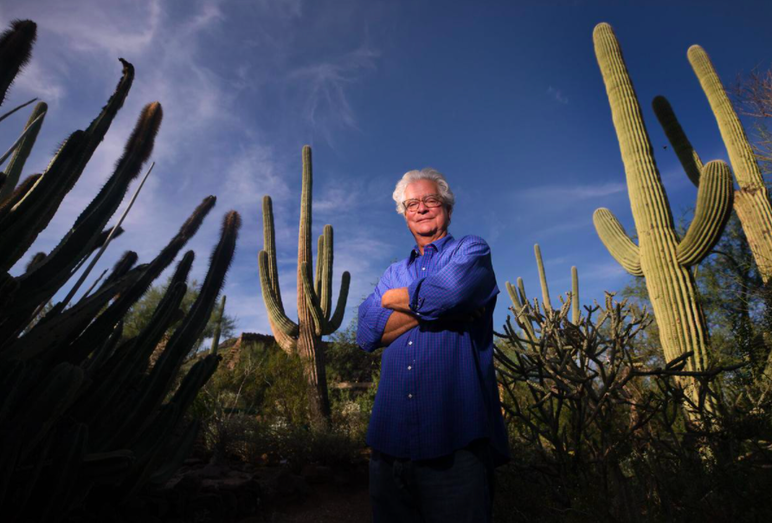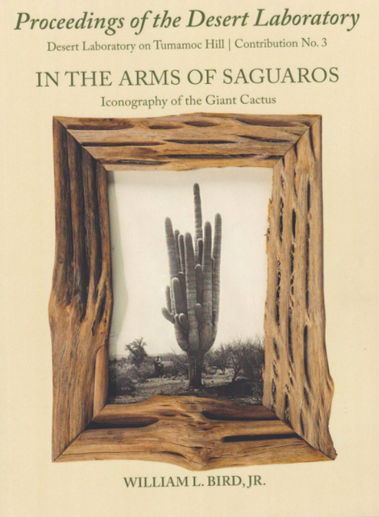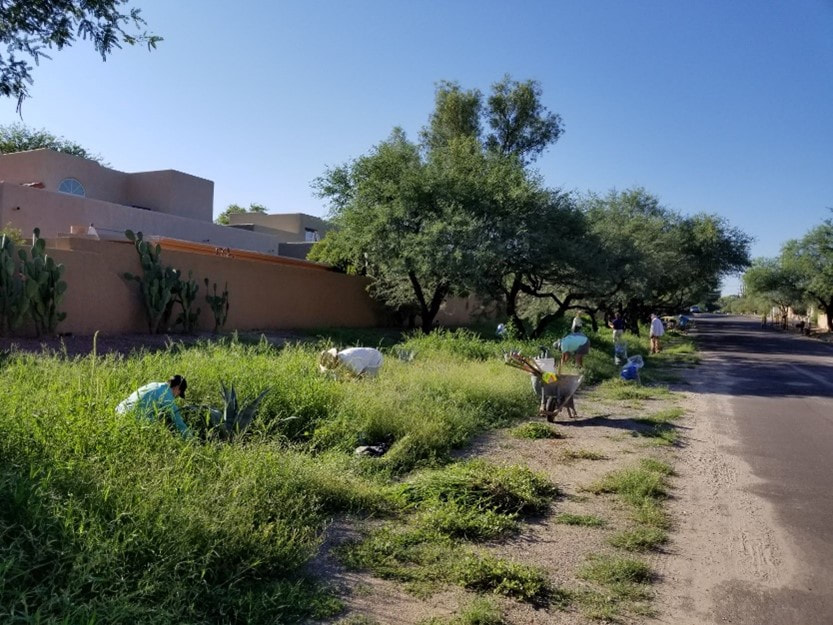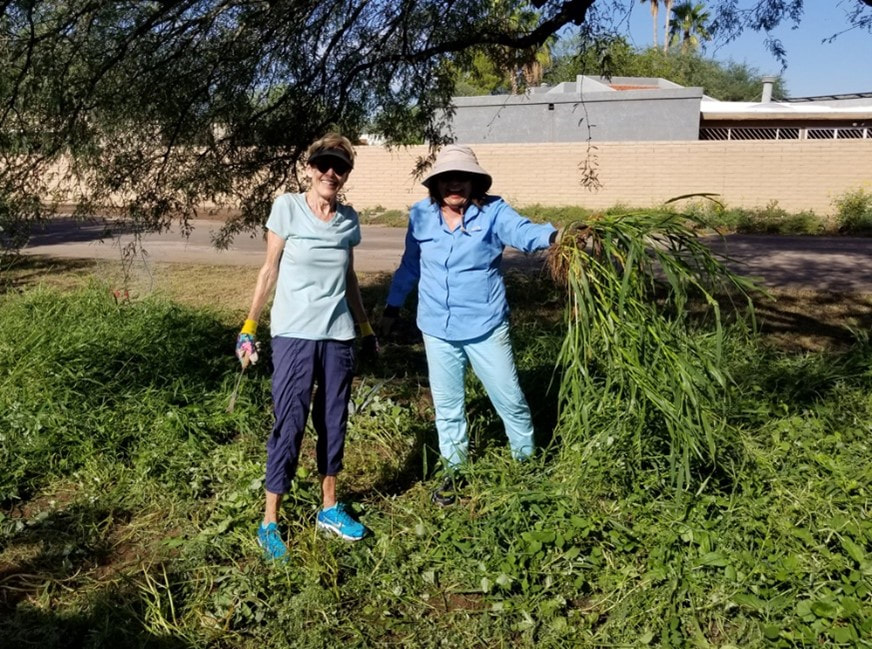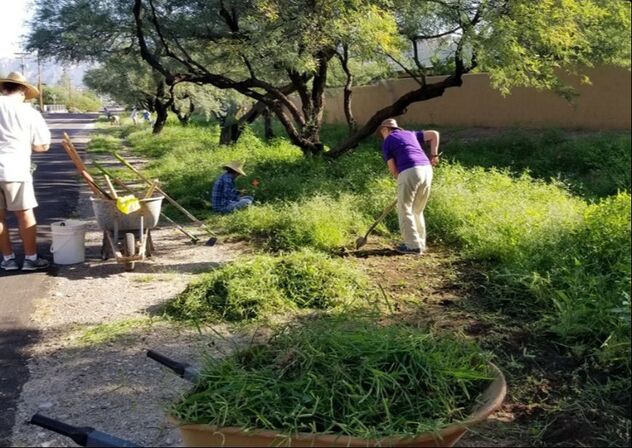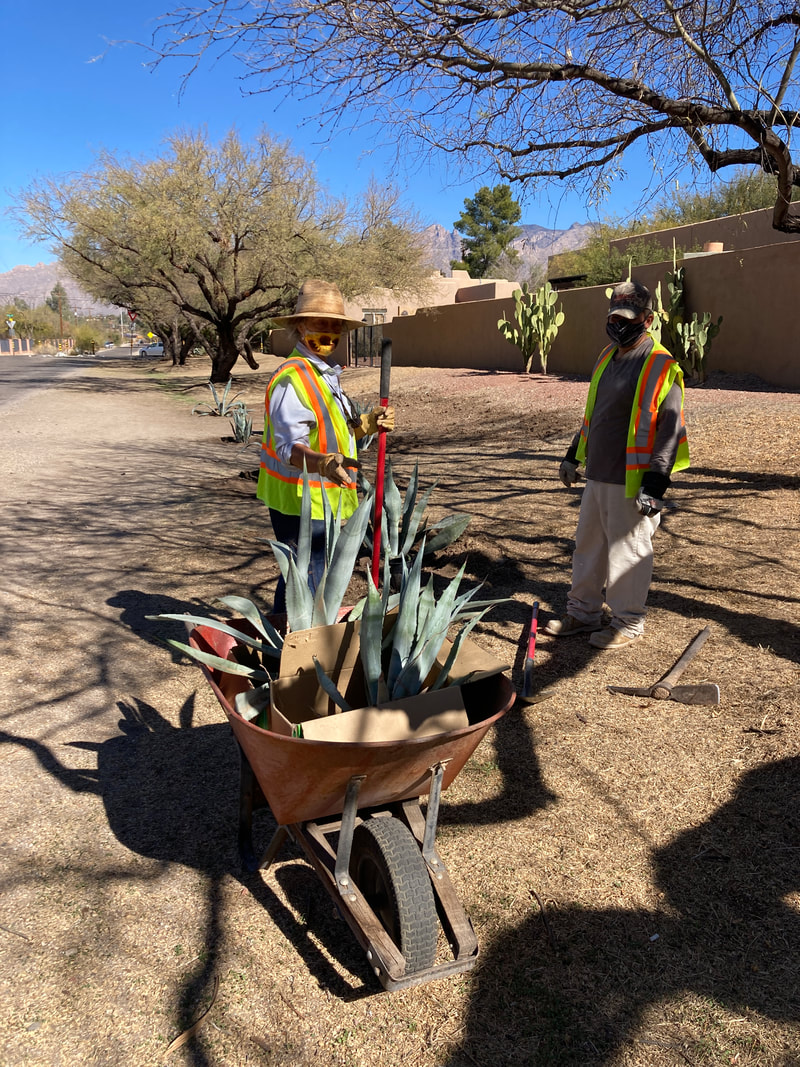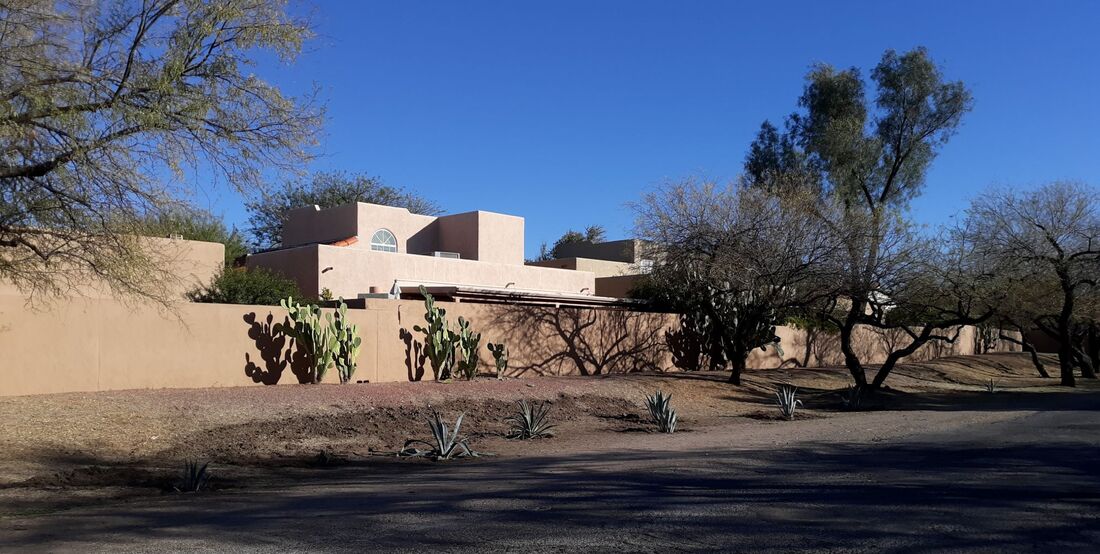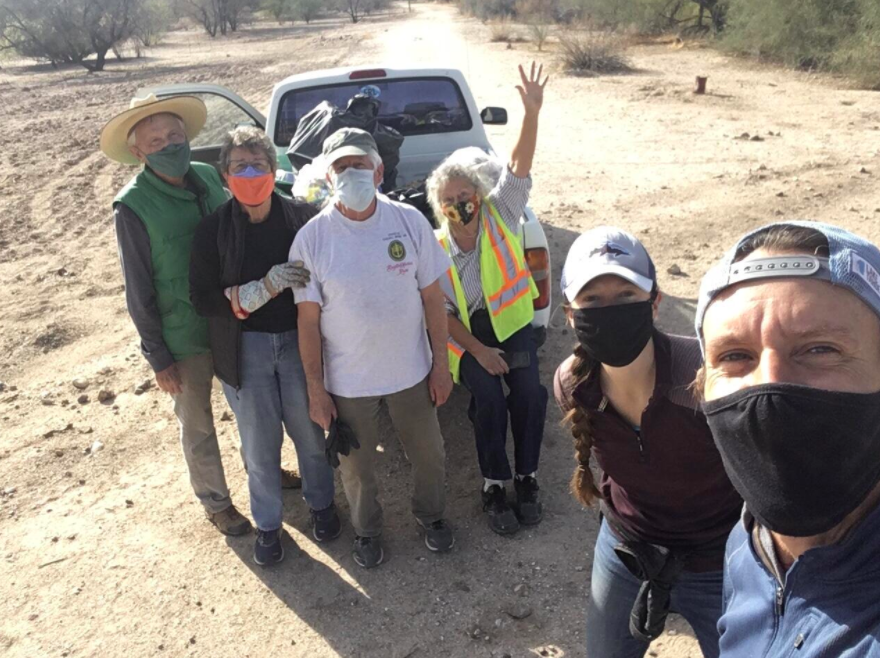
Past NEWS/EVENTS - 2021 and 2022
• RBNA Annual Meeting, Saturday, November 16, 2024 (see past meetings)
• RillitoBend Neighborhood Newsletter 2022, published annually by the City of Tucson
• Unveiling of Parks and Rec's Draft Master Plan for Rio Vista Natural Resource Park, September 7, 2022
• BBC World's New Episode "Desert Worlds" Airs July 27, 2022
• The Queen of the Night's Annual Bloom, June 25, 2022
• Rio Vista: A Place that Owls Call Home, May 2022
• Kick-Off Meeting with Parks and Recreation, April 20, 2022
• Estelle is Awarded a Ben's Bell, March 25, 2022
• Work Day at RIo VIsta Park, January 22, 2022
• Work Day at the Rain Garden, January 15, 2022
• Work Day at RIo Vista Park, December 18, 2021
• What's Happening on Cactus Boulevard... September 2021
• Arizona Daily Star Features New Book by RillitoBend Resident, September 10, 2021
• RillitoBend Neighborhood Newsletter 2021, published annually by the City of Tucson
• RBNA Opposes TEP's Proposal for Overhead Lines Through Tucson, September 8, 2021
• Our New Rain Garden at Rancho Morado, August 2021
• Water Wizards and Stewards of RillitoBend, March 2021
• Clean Up Day, Rio Vista's Christmas Wash, January 23, 2021
• 2020 Year in Review Message from RBNA President, January 4, 2021
• RBNA Annual Meeting, Saturday, November 16, 2024 (see past meetings)
• RillitoBend Neighborhood Newsletter 2022, published annually by the City of Tucson
• Unveiling of Parks and Rec's Draft Master Plan for Rio Vista Natural Resource Park, September 7, 2022
• BBC World's New Episode "Desert Worlds" Airs July 27, 2022
• The Queen of the Night's Annual Bloom, June 25, 2022
• Rio Vista: A Place that Owls Call Home, May 2022
• Kick-Off Meeting with Parks and Recreation, April 20, 2022
• Estelle is Awarded a Ben's Bell, March 25, 2022
• Work Day at RIo VIsta Park, January 22, 2022
• Work Day at the Rain Garden, January 15, 2022
• Work Day at RIo Vista Park, December 18, 2021
• What's Happening on Cactus Boulevard... September 2021
• Arizona Daily Star Features New Book by RillitoBend Resident, September 10, 2021
• RillitoBend Neighborhood Newsletter 2021, published annually by the City of Tucson
• RBNA Opposes TEP's Proposal for Overhead Lines Through Tucson, September 8, 2021
• Our New Rain Garden at Rancho Morado, August 2021
• Water Wizards and Stewards of RillitoBend, March 2021
• Clean Up Day, Rio Vista's Christmas Wash, January 23, 2021
• 2020 Year in Review Message from RBNA President, January 4, 2021
Published annually by the City of Tucson.
About thirty people came out to see what the Parks and Recreation Department is proposing for Rio Vista Park. Tom Fisher, the Parks and Rec Project Manager, and Rick Jones and Eva Zambrano from SmithGroup, the consultant hired to develop the plans, were present to answer any questions. There were large presentation boards and tabloid print outs for the group. About 20 comments were submitted via note paper.
We encourage you to submit your comments to Tom at TomFisher@TucsonAZ.gov. The entire document can be read here:
We encourage you to submit your comments to Tom at TomFisher@TucsonAZ.gov. The entire document can be read here:
A new episode of BBC Studio's Green Planet series will air this Wednesday, July 27th on PBS at 8:00 p.m. We hope you will tune in to watch this special "Desert Worlds" episode that was filmed locally with the help of one of our RillitoBend neighbors.
Local desert ecologists Ben Wilder, Robert Villa, Erin Riordan, and our very own Trica Oshant Hawkins worked with Sir David Attenborough, narrator, and Paul Williams, producer, for three years in order to obtain all the needed footage. The pandemic did not deter them as they ventured to extremely remote locations in Mexico (including the Gran Desierto de Altar and Isla San Pedro Martir) and local desert hot spots such as the Tucson Mountains, Tumamoc Hill, Ironwood Forest National Monument, and Saguaro National Park East.
And unbeknownst to most of us, Sir David was right here in our neighborhood in November 2019, when he and the BBC team were hosted at Trica’s home on Cactus Blvd for a quick lunch between shoots.
Local desert ecologists Ben Wilder, Robert Villa, Erin Riordan, and our very own Trica Oshant Hawkins worked with Sir David Attenborough, narrator, and Paul Williams, producer, for three years in order to obtain all the needed footage. The pandemic did not deter them as they ventured to extremely remote locations in Mexico (including the Gran Desierto de Altar and Isla San Pedro Martir) and local desert hot spots such as the Tucson Mountains, Tumamoc Hill, Ironwood Forest National Monument, and Saguaro National Park East.
And unbeknownst to most of us, Sir David was right here in our neighborhood in November 2019, when he and the BBC team were hosted at Trica’s home on Cactus Blvd for a quick lunch between shoots.
By Murray DeArmond
When we moved here nearly 50 years ago, we were surprised to see a skeletal plant full of white flowers hidden behind an ancestral mesquite tree, located in the back parts of our property near our chicken coop. Even though the sweet-smelling flowers were spent after just one day, the plant was so unusual and spectacular, we decided to move it to a more visible location in order to better keep track of the bloom cycle the following year. When our younger son and I dug around the base of the plant to initiate the transplantation, we soon learned an important lesson. We began to uncover an enormous tuber, the likes of which we had never seen before. Fortunately, we replaced the soil and abandoned the job. It was a good decision as we later learned that these tubers, like huge turnips, can be enormous and weigh up to 100 pounds! Through all these years, the above-ground plant hasn’t changed a lot. All but one day of the year, the plant looks like dead, burnt sticks coming out of the ground and branches. Our Queen has faithfully bloomed one night each year since we’ve lived here.
When we moved here nearly 50 years ago, we were surprised to see a skeletal plant full of white flowers hidden behind an ancestral mesquite tree, located in the back parts of our property near our chicken coop. Even though the sweet-smelling flowers were spent after just one day, the plant was so unusual and spectacular, we decided to move it to a more visible location in order to better keep track of the bloom cycle the following year. When our younger son and I dug around the base of the plant to initiate the transplantation, we soon learned an important lesson. We began to uncover an enormous tuber, the likes of which we had never seen before. Fortunately, we replaced the soil and abandoned the job. It was a good decision as we later learned that these tubers, like huge turnips, can be enormous and weigh up to 100 pounds! Through all these years, the above-ground plant hasn’t changed a lot. All but one day of the year, the plant looks like dead, burnt sticks coming out of the ground and branches. Our Queen has faithfully bloomed one night each year since we’ve lived here.
Photographs by Melanie Campbell-Carter
One evening we were driving home and heard on AZPM that Tohono Chul was initiating a public celebration of the Queen’s appearance in their gardens. We had been following the progress of ours and didn’t think it close to blooming. After we returned home, we checked and, to our surprise, it was also in full bloom. How these plants can bloom on the same, single night out of the year remained a mystery to us. Our neighbor suggested a phenomenon called quantum entanglement* might help to answer the question.
For a number of years, we had a small ritual celebration of the annual bloom. Neighbors and friends get together; sometimes we read the legend; sometimes we toast the Queen; and always we are amazed at this desert miracle.
*Quantum Entanglement
By Trica Oshant Hawkins
As a scientist (a biologist not a quantum physicist), I would at first only propose such a fringe theory among friends. But truly, when one dives into the research on quantum entanglement and synchronous flowering, one finds that yes, there are not only ecological reasons that certain species of plants all bloom on the same night, but quantum theory could indeed, add some explanation.
The primary ecological reason for blooming all at once is essentially an economics of scale. When a plant and its pollinators are not particularly abundant, synchronous blooming of all individuals of that species increases their potential for cross pollination and subsequently decreases the probability that an individual’s fruits will be preyed on (since they would all be fruiting at the same time as well). All this ultimately increases the total seed production, and hence survival, of the species.
While all that makes sense and provides scientific explanation, it doesn’t clearly explain just what environmental cues are stimulating this simultaneous blooming. There are studies that suggest several plausible reasons, including changes in intensity of solar radiation, humidity, photoperiod, temperature, and stress. Additionally, it is important that there are enough pollinators present to make blooming worthwhile and thus, it has been posited that there may be chemical communication cues when pollinator numbers are optimal. These factors may indeed affect plants that are spatially proximate, but what explains the fact that many populations of the Queen are 100s or more miles apart, and yet, they somehow bloom on the exact same night? Certainly temperature, humidity, and solar radiation are too variable between these distant populations to influence such accurate timing. What then, connects these populations and whispers seductively, “tonight’s the night… bloom!”?
Who would argue that there are unseen forces at work here? In fact, isn’t this actually “spooky action at a distance?” So why not quantum entanglement? There is in fact, an infant branch of science called quantum biology, which, for the first time, is revealing quantum entanglement in living organisms.
The bottom line of quantum entanglement is simply that two particles, once entangled, become interdependent regardless of distance. Because it occurs at the tiniest of levels (we’re talking electrons), that original entanglement could certainly occur at a point of original speciation in living organisms and those entangled particles be carried genetically through subsequent generations.
And so, when one Queen in Tucson gets all the right environmental cues and is ready to burst her lovely white blossoms into the night sky luring in hungry sphinx moths, she is instantaneous communicating that with her kin across town, across the region, and across her entire range of existence. Distance be damned. All her kin know and support one another and know that simultaneous flowering helps them all. And behold, for one incredible night, she blooms… and they all bloom. And we mere humans simply witness in awe and wonder. With added assurance from entanglement, long live the Queen.
One evening we were driving home and heard on AZPM that Tohono Chul was initiating a public celebration of the Queen’s appearance in their gardens. We had been following the progress of ours and didn’t think it close to blooming. After we returned home, we checked and, to our surprise, it was also in full bloom. How these plants can bloom on the same, single night out of the year remained a mystery to us. Our neighbor suggested a phenomenon called quantum entanglement* might help to answer the question.
For a number of years, we had a small ritual celebration of the annual bloom. Neighbors and friends get together; sometimes we read the legend; sometimes we toast the Queen; and always we are amazed at this desert miracle.
*Quantum Entanglement
By Trica Oshant Hawkins
As a scientist (a biologist not a quantum physicist), I would at first only propose such a fringe theory among friends. But truly, when one dives into the research on quantum entanglement and synchronous flowering, one finds that yes, there are not only ecological reasons that certain species of plants all bloom on the same night, but quantum theory could indeed, add some explanation.
The primary ecological reason for blooming all at once is essentially an economics of scale. When a plant and its pollinators are not particularly abundant, synchronous blooming of all individuals of that species increases their potential for cross pollination and subsequently decreases the probability that an individual’s fruits will be preyed on (since they would all be fruiting at the same time as well). All this ultimately increases the total seed production, and hence survival, of the species.
While all that makes sense and provides scientific explanation, it doesn’t clearly explain just what environmental cues are stimulating this simultaneous blooming. There are studies that suggest several plausible reasons, including changes in intensity of solar radiation, humidity, photoperiod, temperature, and stress. Additionally, it is important that there are enough pollinators present to make blooming worthwhile and thus, it has been posited that there may be chemical communication cues when pollinator numbers are optimal. These factors may indeed affect plants that are spatially proximate, but what explains the fact that many populations of the Queen are 100s or more miles apart, and yet, they somehow bloom on the exact same night? Certainly temperature, humidity, and solar radiation are too variable between these distant populations to influence such accurate timing. What then, connects these populations and whispers seductively, “tonight’s the night… bloom!”?
Who would argue that there are unseen forces at work here? In fact, isn’t this actually “spooky action at a distance?” So why not quantum entanglement? There is in fact, an infant branch of science called quantum biology, which, for the first time, is revealing quantum entanglement in living organisms.
The bottom line of quantum entanglement is simply that two particles, once entangled, become interdependent regardless of distance. Because it occurs at the tiniest of levels (we’re talking electrons), that original entanglement could certainly occur at a point of original speciation in living organisms and those entangled particles be carried genetically through subsequent generations.
And so, when one Queen in Tucson gets all the right environmental cues and is ready to burst her lovely white blossoms into the night sky luring in hungry sphinx moths, she is instantaneous communicating that with her kin across town, across the region, and across her entire range of existence. Distance be damned. All her kin know and support one another and know that simultaneous flowering helps them all. And behold, for one incredible night, she blooms… and they all bloom. And we mere humans simply witness in awe and wonder. With added assurance from entanglement, long live the Queen.
by Mike Shaw, HawkWatch International
A Western Screech-Owl roosted in one of the nest boxes in Rio Vista Park from December through mid February, before unexpectedly disappearing. Weeks later, on March 24th, another owl, possibly the same one, was found in the same box along with two eggs. A check on April 9th revealed a female incubating five eggs.
Our long term HawkWatch International study of cavity nesting raptors had fourteen Screech-Owls using nest boxes in and around Tucson last year . None of those nesting owls had more than three eggs inside. This spring, the Rio Vista owl is the second nest we've found with five eggs, and several other nest boxes have four. Perhaps the abundance of eggs is a response to the continued effects from last year's incredible monsoon season? Healthier habitat certainly increases food resources and ultimately a bird's body conditioning. In addition to the Rio Vista owls, there are two other pairs known to be nesting adjacent to the Park in private residences along Cactus and Allen.
Our long term HawkWatch International study of cavity nesting raptors had fourteen Screech-Owls using nest boxes in and around Tucson last year . None of those nesting owls had more than three eggs inside. This spring, the Rio Vista owl is the second nest we've found with five eggs, and several other nest boxes have four. Perhaps the abundance of eggs is a response to the continued effects from last year's incredible monsoon season? Healthier habitat certainly increases food resources and ultimately a bird's body conditioning. In addition to the Rio Vista owls, there are two other pairs known to be nesting adjacent to the Park in private residences along Cactus and Allen.
Mike Shaw descending from the 20' ladder with a bucket of owlets—four of them! Female Western Screech-Owl inside the RIo Vista nest box, March 2022
Four of the five Rio Vista eggs hatched in late April. On Saturday May 19th, the twenty-something day old chicks were weighed, measured and banded.
The 24-day-old owlet weighing in at 98 grams. Others just staring.
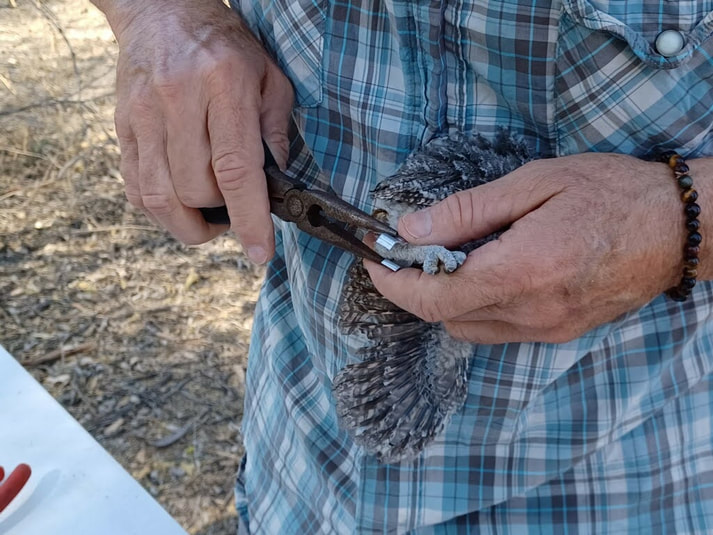 Banding
Banding
For more info on HawkWatch International projects and programs:
www.hawkwatch.org
For those with nest boxes wishing to join the study:
email mshaw@hawkwatch.org
Fun Facts:
Lifespan of a screech owl:
oldest known wild bird was 14 yrs. 4 mos.
Highest mortality rate is in the first year of life. Owls that make it to adulthood are thought to have an average lifespan of 3-7 years.
Size: about 20cm or 8”
Weight: about 140gm or 5oz.
Male and female look the same?
yes, although females are bigger
www.hawkwatch.org
For those with nest boxes wishing to join the study:
email mshaw@hawkwatch.org
Fun Facts:
Lifespan of a screech owl:
oldest known wild bird was 14 yrs. 4 mos.
Highest mortality rate is in the first year of life. Owls that make it to adulthood are thought to have an average lifespan of 3-7 years.
Size: about 20cm or 8”
Weight: about 140gm or 5oz.
Male and female look the same?
yes, although females are bigger
A feather sample was taken for future isotope and genomic analysis. The uniquely numbered leg bands will allow us to better understand how individuals navigate and disperse through our urban landscape as it changes over time.
Screech-owl fledglings usually leave the nest at about thirty days, so they should soon be out and about. Perhaps you’ll catch sight of one perched on a branch in the Park or silhouetted against the sky. However, for the sake of letting them carry on with their purpose undisturbed, I suggest forgetting they're even there while enjoying time in such an accessible and unique urban resource. Doing so makes a serendipitous encounter with a neighboring owl even more rewarding.
Screech-owl fledglings usually leave the nest at about thirty days, so they should soon be out and about. Perhaps you’ll catch sight of one perched on a branch in the Park or silhouetted against the sky. However, for the sake of letting them carry on with their purpose undisturbed, I suggest forgetting they're even there while enjoying time in such an accessible and unique urban resource. Doing so makes a serendipitous encounter with a neighboring owl even more rewarding.
Over fifty people gathered at the ramada at Rio Vista Park for an open house with representatives from Tucson’s Department of Parks and Recreation and Smith Group. The topic: updating the Master Plan for Rio Vista. The project is slated for Fiscal Year 2023-2025.
Tom Fisher, Parks and Recreation's Project Manager, introduced Rick Jones, the consultant from SmithGroup, as well as other colleagues Greg Jackson and Mike Hayes, Deputy Directors, and distinguished guests Kevin Dahl and Karen Ulrich, present and former Ward 3 Council Members. Tom invited the group to talk about the park, and that they did. Comments ranged from “we need to define ‘natural resource park’”; “how can we be a natural resource park without recycling cans in the park?”, “let’s invest in green, gray and brown infrastructure”; and “can we slow down the traffic on Tucson Boulevard?; I am a horse person.” The group broke up into smaller groups and talked individually with each other and with Parks and Rec staff. It was impressive to see such a terrific turnout.
Tom Fisher, Parks and Recreation's Project Manager, introduced Rick Jones, the consultant from SmithGroup, as well as other colleagues Greg Jackson and Mike Hayes, Deputy Directors, and distinguished guests Kevin Dahl and Karen Ulrich, present and former Ward 3 Council Members. Tom invited the group to talk about the park, and that they did. Comments ranged from “we need to define ‘natural resource park’”; “how can we be a natural resource park without recycling cans in the park?”, “let’s invest in green, gray and brown infrastructure”; and “can we slow down the traffic on Tucson Boulevard?; I am a horse person.” The group broke up into smaller groups and talked individually with each other and with Parks and Rec staff. It was impressive to see such a terrific turnout.
If you haven't done so already, PLEASE take the survey HERE
Above, clockwise from left: Justin and Sue Ann speak to Tom about the soil and vegetation in the park; Melanie makes her points known to Rick: former Council Member Karen Ulrich looks on; Ward 3 Council Member Kevin Dahl speaks to the group.
Below: Park advocates with poster of neighborhood projects.
Below: Park advocates with poster of neighborhood projects.
On March 25th, Estelle Stern-Eilers was awarded the Ben’s Bell Award for her recognition as a person who touches so many through her kindness. She got “belled!”
About 40 people showed up to surprise and support Estelle, including our Ward 3 Council Member Kevin Dahl. Liz Levine from Ben’s Bells, read the nomination from Howard Weiss citing Estelle as "the catalyst for improving and beautifying the RillitoBend neighborhood." There was a chorus of clapping as she presented Estelle with the signature wind chimes, made of a ceramic flower, a small brass bell and several ceramic pieces. Estelle was so touched—and surprised—by the recognition. It was a joyous time for all.
About 40 people showed up to surprise and support Estelle, including our Ward 3 Council Member Kevin Dahl. Liz Levine from Ben’s Bells, read the nomination from Howard Weiss citing Estelle as "the catalyst for improving and beautifying the RillitoBend neighborhood." There was a chorus of clapping as she presented Estelle with the signature wind chimes, made of a ceramic flower, a small brass bell and several ceramic pieces. Estelle was so touched—and surprised—by the recognition. It was a joyous time for all.
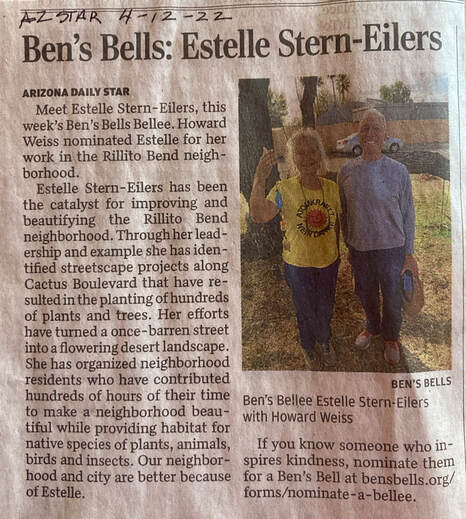
Media events featuring Estelle's Belling are:
1. 94.9 MixFM “Greg & Mere in the Morning” radio show at 8:20am on Friday, 4/8/2022
2. The Arizona Daily Star on Tuesday, 4/12/2022
3. www.bensbells.org on Friday, 4/8/2022
4. www.facebook.com/bensbellsproject and @bensbells on Sunday, 4/10/2022
1. 94.9 MixFM “Greg & Mere in the Morning” radio show at 8:20am on Friday, 4/8/2022
2. The Arizona Daily Star on Tuesday, 4/12/2022
3. www.bensbells.org on Friday, 4/8/2022
4. www.facebook.com/bensbellsproject and @bensbells on Sunday, 4/10/2022
The day was sunny and cool. The work crew (Catlow, Estelle, John, Josh, Larry, Lindy, Michele, Murray, Pat, Stephen, Steve, Sue and Terry) focused at the southeast corner of the Park. Swales were dug out around the eucalyptus to help retain water. Several large African sumac (was named Rhus lancea now Searsia lancea) that were crowding out the mesquite in the area were cut down—a major accomplishment. We also started to assess and work on enhancing the stormwater flow into that corner of the Park. Future work will be to coordinate with Parks and Rec to increase flow into and through the Park.
Left to right: Catlow and Steve cutting Rhus lancia; Murray and John hauling; and underbrush
Many neighbors—Lindy, Steve, Terry, Catlow, Rich, Estelle, Larry, Michele, Stephan, Tamzin, Claire, Phoebe, Leila, Josh, Pat, Matthew, Julie, Mike, Bennet, and Carol—showed up to work tidying up and further enhancing the Rain Garden on Cactus Blvd. What a productive day!
The garden was transformed into a real Rain Garden, replete with swales, rock berms, rock dams, media lunas, and rock vehicle barriers (boulders). Thank you, Catlow Shipek from Watershed Management Group, for sharing your expertise in this neighborhood showcase.
Questions? Email Estelle Stern-Eilers at estellestern@gmail.com.
For more information on Rain Gardens go to Watershed Management Group’s website: https://watershedmg.org/document/rain-garden-care-handbook.
This project is part of the larger vision for the RBNA, go to https://rillitobendna.org/our-vision.html.
The garden was transformed into a real Rain Garden, replete with swales, rock berms, rock dams, media lunas, and rock vehicle barriers (boulders). Thank you, Catlow Shipek from Watershed Management Group, for sharing your expertise in this neighborhood showcase.
Questions? Email Estelle Stern-Eilers at estellestern@gmail.com.
For more information on Rain Gardens go to Watershed Management Group’s website: https://watershedmg.org/document/rain-garden-care-handbook.
This project is part of the larger vision for the RBNA, go to https://rillitobendna.org/our-vision.html.
Pre-work gathering
Left to right: RBNA President Lindy and Estelle the organizer; Bennet Bernal from Ward 3 and Estelle; digging a hole for a rock vehicle barrier, a large boulder to deter vehicles from entering the Rain Garden
Left to right: Rich from Hitching Post Ranch at Gentleman’s Acres dumping rocks; Catlow who provided the rock dam expertise; Mike hauling rocks
Left to right: Rich and Mike start to build a media luna, a crescent-shaped dam; Larry and Matthew work on a rock dam, a low profile dam across a channel to slow water and stabilize soil surface; Mike puts the finishing touches on the media luna, used to slow down and spread water.
Left to right: A rock berm, a curved rock wall on the downstream side of an agave, captures water and provides lizard habitat; Tamzin, Claire, and Phoebe; our sign
We had a productive day cleaning up the Park on a recent Saturday. Led by RBNA Board Member Estelle Stern-Eilers, over a dozen people showed up this chilly Saturday morning to dig out buffelgrass, prune mesquites, trim African Sumac, create swales around agaves, and pick up garbage. It made Estelle very happy to have such help, so thank you Kevin, Mike, Pat, Lindy, John, Larry, Jane, Tamzin, Claire, Pat, Catlow, Josh and Terry!! A special treat was seeing Kevin Dahl, our new Ward 3 Councilmember, who joined in the fun. And it was also good to see some new faces: we hope to see you again!
Above: Some of those who turned out to help were, l to r, Ward 3 Councilmember Kevin Dahl, Mike Shaw of Hawkwatch, our fearless leader Estelle Stern-Eilers, our new RBNA president Lindy Brigham. Jane Bethel, RBNA Vice-President Mary Bird, and former RBNA president John Kovacik.
Above, clockwise: Estelle giving instructions; Kevin and Larry pruning; Terry picking up garbage; Claire and Tamzin tending the agave
Underneath the heritage mesquite trees on Cactus Boulevard is an active ecosystem of butterflies, bees, native plants, new mesquite trees and more. Here, neighborhood volunteers are working to create a Rain Garden. They are weeding and cutting back invasive plants (like Bermuda grass) and protecting the more precious plants with wire weirs. It may look like weeds out of control, but it is not!
Three sandwich board signs are now being used when our volunteers are working in the neighborhood. The signs are double-sided: on one side, a handwritten (temporary) sign explains the activity nearby; on the other (permanent) side Rafe Sagarin is remembered with his assemblage of graphics celebrating the special nature of our community.
For those interested in native plants, we have a new database of most of the plants in the Rain Garden. Go to https://www.plantsmap.com/organization/plants. RillitoBend neighbors have included photos and write-ups; all are welcome to contribute photos of the plants in the garden by emailing them to flowers@rillitobendna.org.
Some plants in the Garden are still in bloom, such as Ivy Leaf Morning Glory (Ipomoea hederacea), Datura (Datura stramonium) and Cinderella Weed (Synedrella nodiflora). Come and see: the purple morning glories are lovely!
We continue to work with the City of Tucson and the Rancho Morado Homeowners to further enhance the Garden. We plan to install boulders to protect the Garden from vehicles and smaller rocks to create check dams to catch water. We will be scheduling work sessions to control invasive plants and protect our native plant environment. Look for emails from RillitoBend Neighborhood and for our workday signs.
Three sandwich board signs are now being used when our volunteers are working in the neighborhood. The signs are double-sided: on one side, a handwritten (temporary) sign explains the activity nearby; on the other (permanent) side Rafe Sagarin is remembered with his assemblage of graphics celebrating the special nature of our community.
For those interested in native plants, we have a new database of most of the plants in the Rain Garden. Go to https://www.plantsmap.com/organization/plants. RillitoBend neighbors have included photos and write-ups; all are welcome to contribute photos of the plants in the garden by emailing them to flowers@rillitobendna.org.
Some plants in the Garden are still in bloom, such as Ivy Leaf Morning Glory (Ipomoea hederacea), Datura (Datura stramonium) and Cinderella Weed (Synedrella nodiflora). Come and see: the purple morning glories are lovely!
We continue to work with the City of Tucson and the Rancho Morado Homeowners to further enhance the Garden. We plan to install boulders to protect the Garden from vehicles and smaller rocks to create check dams to catch water. We will be scheduling work sessions to control invasive plants and protect our native plant environment. Look for emails from RillitoBend Neighborhood and for our workday signs.
.Above left: One of our new signs featuring graphics by former neighbor Rafe Sagarin, with volunteer Lindy Brigham pulling out invasive Bermuda grass
Above right: Stephen Brigham, RillitoBend Neighborhood Association President, uses a weed whacker to cut back Bermuda grass from the roadway edge pedestrian path.
Above right: Stephen Brigham, RillitoBend Neighborhood Association President, uses a weed whacker to cut back Bermuda grass from the roadway edge pedestrian path.
William L. Bird is featured in the Arizona Daily Star for his new book, In the Arms of Saguaros: Iconography of the Giant Cactus.
Read all about it! Click HERE
To download your own pdf of the article click HERE
Published annually by the City of Tucson
The RBNA Board submitted a letter of opposition to TEP’s proposal for overhead transmission lines through Tucson as part of the Kino to DeMoss-Petrie Transmission Line Project. On Sept 1, the Mayor and City Council unanimously decided to intervene as a party on the issue and to inform TEP they do not agree with TEP’s proposals unless ordinances are followed which call for undergrounding utilities.
To read RBNA’s letter, click here:
To read RBNA’s letter, click here:
We encourage residents to act now by going to:
https://efiling.azcc.gov/online-services/utilities-public-comment-external Fill in in all your pertinent info, then the name of Company - Tucson Electric Power, Docket number L-00000C-21-0288-00192, Indicate if you are for, against, or neutral, then fill in your comments.
For complete directions and info from the issues/ opinions in the sample letter go to:
http://www.jeffersonpark.info/tep-138-kv-poles.html
https://efiling.azcc.gov/online-services/utilities-public-comment-external Fill in in all your pertinent info, then the name of Company - Tucson Electric Power, Docket number L-00000C-21-0288-00192, Indicate if you are for, against, or neutral, then fill in your comments.
For complete directions and info from the issues/ opinions in the sample letter go to:
http://www.jeffersonpark.info/tep-138-kv-poles.html
Our New Rain Garden at Rancho Morado, August 2021
The rains have been spectacular this monsoon season: over 13” and counting! The mesquite grove on Cactus outside Rancho Morado has come alive with plants unseen for years. To think that just months ago, worries about the mesquite grove prompted us to apply for a grant to install boulders to prevent further degradation of the soil from parked vehicles (read the proposal HERE). And though we did not secure funding, Ward 3 office connected us City Transportation and they are going to find the boulders and rocks we need, so stay tuned!
With the rains, Estelle Stern-Eilers arranged for a partnership with the Watershed Management Group’s (WMG) River Run Network to learn how to retain stormwater and encourage native habitat. We’ve adapted WMG’s term “rain garden” as it aptly fits our intention to capture rain and create a garden. Over 30 neighbors showed up at the first workday on August 21st. And by the end of the second work day on August 29th, 40 bags of unwanted vegetation, each weighing about 25 pounds, were removed! Neighbors volunteered their trash bins to dispose of the greens. More work needs to be done, but we are proud of what we have accomplished so far.
We have started a list of the plants identified at the rain garden. Though incomplete, here is the LINK for those interested: . If you see a plant mis-identified or know the name of one that is listed as unknown, please email us at rbna@rillitobendna.org. Also, if you have taken photos that you would like to contribute, please send them!
The next phase is to place the boulders when they arrive and build more check dams and swales to retain water for the rain garden. We will be monitoring the plants and will keep you posted on their progress and ask for help when needed.
Thank you, WMG and volunteers, for your help!
For more information about WMG, visit https://watershedmg.org/river-run-network.
The rains have been spectacular this monsoon season: over 13” and counting! The mesquite grove on Cactus outside Rancho Morado has come alive with plants unseen for years. To think that just months ago, worries about the mesquite grove prompted us to apply for a grant to install boulders to prevent further degradation of the soil from parked vehicles (read the proposal HERE). And though we did not secure funding, Ward 3 office connected us City Transportation and they are going to find the boulders and rocks we need, so stay tuned!
With the rains, Estelle Stern-Eilers arranged for a partnership with the Watershed Management Group’s (WMG) River Run Network to learn how to retain stormwater and encourage native habitat. We’ve adapted WMG’s term “rain garden” as it aptly fits our intention to capture rain and create a garden. Over 30 neighbors showed up at the first workday on August 21st. And by the end of the second work day on August 29th, 40 bags of unwanted vegetation, each weighing about 25 pounds, were removed! Neighbors volunteered their trash bins to dispose of the greens. More work needs to be done, but we are proud of what we have accomplished so far.
We have started a list of the plants identified at the rain garden. Though incomplete, here is the LINK for those interested: . If you see a plant mis-identified or know the name of one that is listed as unknown, please email us at rbna@rillitobendna.org. Also, if you have taken photos that you would like to contribute, please send them!
The next phase is to place the boulders when they arrive and build more check dams and swales to retain water for the rain garden. We will be monitoring the plants and will keep you posted on their progress and ask for help when needed.
Thank you, WMG and volunteers, for your help!
For more information about WMG, visit https://watershedmg.org/river-run-network.
|
Above left:
Volunteers pulling out unwanted vegetation at the mesquite grove on Cactus Blvd. Above right: Rancho Morado residents Sylvia Lee and Jan Crebbs, holding a large clump of Johnson grass. At left: Looking north along Cactus Blvd. Compare this view with the one in the next story! FYI: A swale is a depression (natural or human-made) with gently sloped sides that captures or channels stormwater. Artificial ones are designed to slow down and collect runoff, facilitating infiltration into the soil. A check dam is a small dam built across a drainage ditch or swale to reduce water flow, allowing water to collect and soak into the soil. |
|
From Estelle Stern-Eilers
In RillitoBend we have Water Wizards and Stewards! They are our unsung heroes who care for the plants along the rights-of-way in the neighborhood. • At the roundabout at Cactus and Allen, Murray and Sue DeArmond are the Water Stewards; • On Allen Road, Paula Datsko and other Meadow View residents take care of the new plants along the their wall; Rachel Hopkins and Matthew Vasquez take care of plantings at other parts of Allen Road; • On Cactus, along the wall at Winterhaven Village Townhouses, Estelle and Winterhaven residents take care of this linear garden; • At the entrance to Rio Vista Natural Resource Park at the labyrinth, Mary Alice Keller comes with cans of water to hydrate the plants; • At Valley of the Moon—where they are called Water Wizards--Estelle Stern-Eilers is one of the volunteers taking care of the plants; • And last but not least, the newly planted agaves on Cactus at Rancho Morado are watered by Kit and other Rancho Morado residents. More about the newly planted agaves on Cactus: With the support from the landscaping committee of Rancho Morado, we planted three species of agave: blue agave (Agave tequilana), American century plant (Agave Americana) and two Hohokam agaves (Agave murpheyi) that the Hohokam people cultivated for food and fiber in Southern Arizona and Northern Sonora. The agaves have been planted in the mesquite grove along Cactus as a visual border to deter vehicles from turning and parking in that area. The area is in a swale where we want to collect stormwater to benefit the |
trees. Neighbors from Rancho Morado are donating water from their homes to help establish these agaves in their new home. Thank you all who are promoting to beautify our neighborhood for humans and supporting our urban wildlife! |
Clean Up Day: Christmas Wash, January 23, 2021
|

